Advance Multimedia Internet Technology MGB100 Portable Wireless AP Storage User Manual
Advance Multimedia Internet Technology Inc. Portable Wireless AP Storage Users Manual
Users Manual
MGB100
Portable Wireless AP Storage
(for 2.5” HDD use)
USER MANUAL
Ver. 1.01
2
Copyright
The contents of this publication may not be reproduced in any part or as a
whole, stored, transcribed in an information retrieval system, translated into
any language, or transmitted in any form or by any means, mechanical,
magnetic, electronic, optical, photocopying, manual, or otherwise, without the
prior written permission.
Trademarks
All products, company, brand names are trademarks or registered trademarks
of their respective companies. They are used for identification purpose only.
Specifications are subject to be changed without prior notice.
FCC Interference Statement
This equipment has been tested and found to comply with the limits for a
Class B digital device pursuant to Part 15 of the FCC Rules. These limits are
designed to provide reasonable protection against radio interference in a
commercial environment. This equipment can generate, use and radiate radio
frequency energy and, if not installed and used in accordance with the
instructions in this manual, may cause harmful interference to radio
communications. Operation of this equipment in a residential area is likely to
cause interference, in which case the user, at his own expense, will be
required to take whatever measures are necessary to correct the interference.
CE Declaration of Conformity
This equipment complies with the requirements relating to electromagnetic
compatibility, EN 55022/A1 Class B.
Note. The content of user manual will be revised without notice.
3
Table of Contents
Chapter 1: Introduction.................................................................................... 5
1.1 Overview........................................................................................... 5
1.2 Features ........................................................................................... 6
1.3 System Requirements...................................................................... 7
1.4 Package List..................................................................................... 8
1.5 Hardware Ports and Buttons ............................................................ 9
1.6 LED Indicators................................................................................ 10
Chapter 2: Getting Started ............................................................................ 11
2.1 Hard Disk installation.......................................................................11
2.2 Making Connections....................................................................... 14
2.2.1 Check TCP/IP Settings ....................................................... 14
2.2.2 Wireless Connection:.......................................................... 22
2.3 File sharing..................................................................................... 24
2.3.1 Accessing the network hard drive via my network places .. 24
2.3.2 Searching the computers.................................................... 25
2.3.3 Search the “Entire Network” Manually................................ 25
2.3.4 Accessing files via FTP....................................................... 26
Chapter 3: Making Configuration .................................................................. 27
3.1 Wizard ............................................................................................ 29
3.2 Network Settings ............................................................................ 37
3.2.1 DHCP Setting...................................................................... 37
3.2.2 Wireless Setting.................................................................. 39
Chapter 4: Disk Management ....................................................................... 55
4.1 Disk Utility....................................................................................... 55
4
Chapter 5: ADVANCED FUNCTIONS .......................................................... 58
5.1 Config Backup ................................................................................ 58
5.2 Reset to Default.............................................................................. 58
5.3 Reboot............................................................................................ 58
5.4 F/W Upgrade .................................................................................. 58
Chapter 6: MISC ........................................................................................... 59
6.1 Administrator Timeout..................................................................... 59
6.2 Change Password.......................................................................... 60
6.3 System Time................................................................................... 61
Chapter 7: Trouble Shootings ....................................................................... 62
What can I do when I have some trouble in the first time? .................. 62
How to setup wireless function?........................................................... 64
Problems of security level .................................................................... 75

5
C
C
Ch
h
ha
a
ap
p
pt
t
te
e
er
r
r
1
1
1:
:
:
I
I
In
n
nt
t
tr
r
ro
o
od
d
du
u
uc
c
ct
t
ti
i
io
o
on
n
n
Congratulations on your purchase of this outstanding Storage device. This
product is specifically designed for Small Office and Home Office needs. It
provides a complete SOHO solution for Internet surfing, and is easy to
configure and operate even for non-technical users. Instructions for installing
and configuring this product can be found in this manual. Before you install
and use this product, please read this manual carefully for fully exploiting the
functions of this product.
1.1 Overview
The MGB100 is an ultra slim design and compact size of Portable Wireless
AP Storage. It is an ideal device for travelers and home users who need to
back up and share files more efficiently and easily anytime and anywhere.
Additionally, Network storage and fully compliant IEEE 802.11g WLAN device
functions let you share files easily.
The MGB100 offers WLAN mobility for home user and business people to
maintain continuous network connectivity. Home users can stay connected to
the network anywhere through a building without being limited by LAN cables
via MGB100’s AP functionality. This device also has the additional advantage
of providing network storage with its 2.5-inch hard disk drive which allows you
to share information and storage capacity via wireless or wired network. The
MGB100 supports the UPnP content directories and users can share the

6
music and video files easily. Besides, the click-and-copying of files from a
flash drive to the MGB100 hard disk make the user backup files efficiently.
1.2 Features
Basic functions
z Ultra DMA 133 IDE controller to adapt for 2.5-inch hard disk
drive.
z Network File Storage and File Sharing via the Network
Neighborhood (or My Network Places) in Windows or Samba in
Linux.
z Support FAT, FAT32, Ext2 files system and can read NTFS file
system. (Only can copy files from NTFS folder to another FAT,
FAT32, or Ext2 folder.)
z Built-in FTP server.
z Support Security level as guest or Authorization user for file
sharing.
z UPnP (Universal Plug and Play) feature for Windows XP and
Windows Me.
z Real time clock to synchronize the computer time setting.
z Easy to upgrade: using Web or Windows Application to upgrade
new version of firmware.
z Browser-based interface configuration and management: OS
independent, easy-to-use for consumer installation.

7
USB device
z Built-in USB2.0 host to connect to USB mass storage device,
like USB flash drive, USB Hard Drive, etc...
z Easy to button: Offer the Button to Copy folders and files form
USB device to HDD.
Wireless functions
z Up to 54Mbps data rate by incorporating Orthogonal Frequency
Division Multiplexing (OFDM).
z IEEE 802.11b compatible (11Mbps): Allowing inter-operation
among multiple vendors.
z IEEE 802.11g compatible (54Mbps): Allowing inter-operation
among multiple vendors.
z Wireless data rate supported: 6/12/18/24/36/48/54 Mbps in
802.11g mode; 1/2/5.5/11Mbps in 802.11b mode.
z 64/128-bit WEP encryption.
z Support 802.1X authentication.
z Support WPA with TKIP and AES encryption.
z Support AP and WDS wireless modes.
1.3 System Requirements
To start to use the MGB100, your system must have the following minimum
requirements:
z Windows 95 / 98 / ME / 2000 / XP.
z An Ethernet (10BaseT or 10/100 BaseT) adapter for wired client.
z At least one WLAN client adapter of 802.11g(54Mbps) or
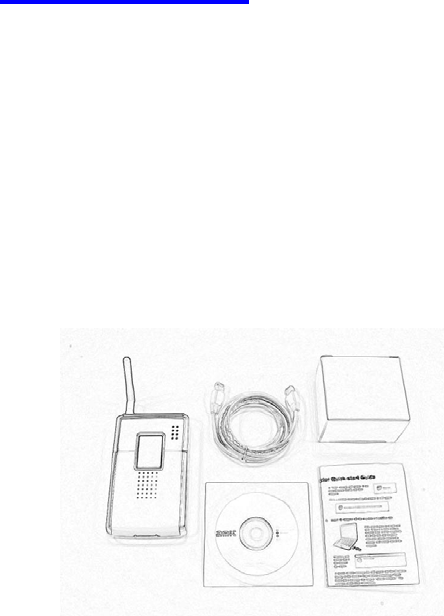
802.11b(11Mbps) for wireless connection.
z TCP/IP and NetBIOS network protocol installed.
z Internet Browser installed.
The MGB100 requires an external 5V, 3A power supply which is included in
the MGB100 package. For safe operation, please use only the power adapter
provided by MGB100.
1.4 Package List
The MGB100 package contains the following items:
z MGB100 x 1
z 2.4GHz dipole antenna x 1
z Power Adapter (5 Volts DC, 3A) x 1
z RJ-45 Ethernet cable
z Quick guide
z CD(utilities and user manual) x 1
z Screws x 2 (Fix hard drive)
8
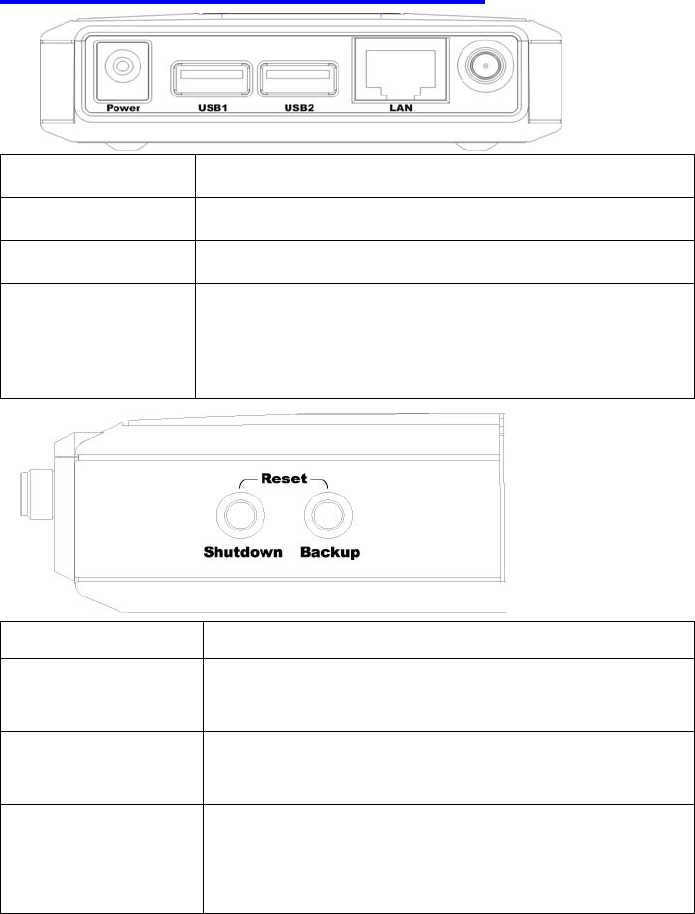
1.5 Hardware Ports and Buttons
Ports Description
Power 5V/3A Power inlet
USB1 / USB2 The ports where you can connect to any USB storage.
LAN Automatically MDI/MDIX LAN port can sense the
cable type when connecting to Ethernet-enabled
computer, network of hub, switch or router
Buttons Description
Shutdown Press the button for 4 seconds to shut down the
whole system before power-off.
Backup Press the button over 4 seconds to copy data from
USB device to HDD.
Reset Press the buttons of “Shutdown” and “Backup”
simultaneously over 6 seconds to reset the system to
the factory default setting.
9

1.6 LED Indicators
USB 1 Power
USB 2 LAN
Backup WLAN
HDD
HDD Status
LED Off On Blinking
PWR Power off Power on
LAN No device Linked In use
WLAN No packet On Transmitting
HDD Not in use HDD read/write
USB1 / USB2 No device USB drive ready
Backup Backup files from
USB to HDD
HDD Status No HDD HDD full or error More blinking
quickly, fewer
available HDD
capacity.
10
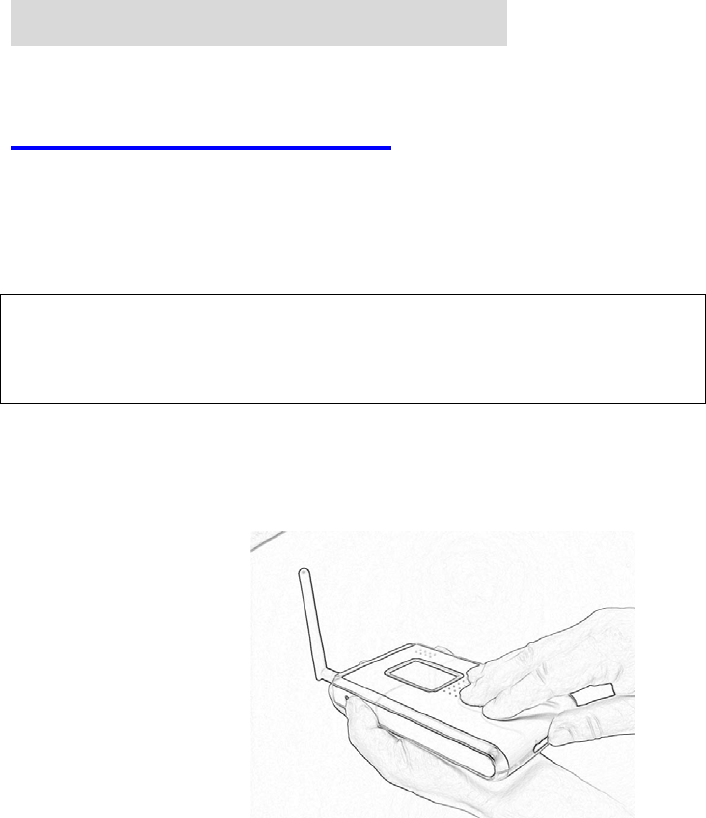
11
C
C
Ch
h
ha
a
ap
p
pt
t
te
e
er
r
r
2
2
2:
:
:
G
G
Ge
e
et
t
tt
t
ti
i
in
n
ng
g
gS
S
St
t
ta
a
ar
r
rt
t
te
e
ed
d
d
2.1 Hard Disk installation
Follow the steps below to insert the 2.5-inch hard disk and assemble the
device before using the MGB100.
Warning: The MGB100 is not hot-swappable. Please make sure that it is
turned off and not connected to the power outlet when performing the
following assembly procedure.
Step 1: Use one hand to hold on the MGB100, and the other hand to open the
upper cover carefully.
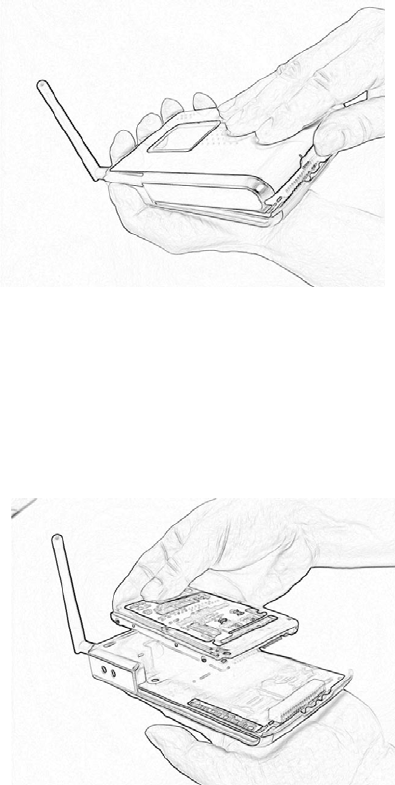
Step 2: Remove the upper cover
Step 3: Insert the 2.5-inch hard drive into the slot. Make sure the hard drive
connecting pins and the connectors are properly aligned.
12
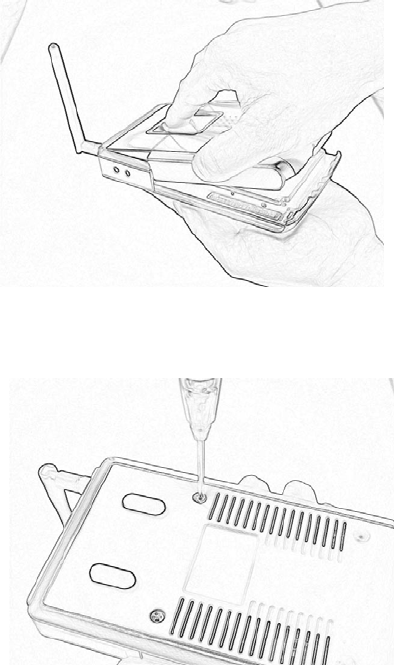
Step 4: Put the upper cover back and assemble the cover tightly.
Step 5: Fasten the screw to make sure the hard drive would not loosen.
13
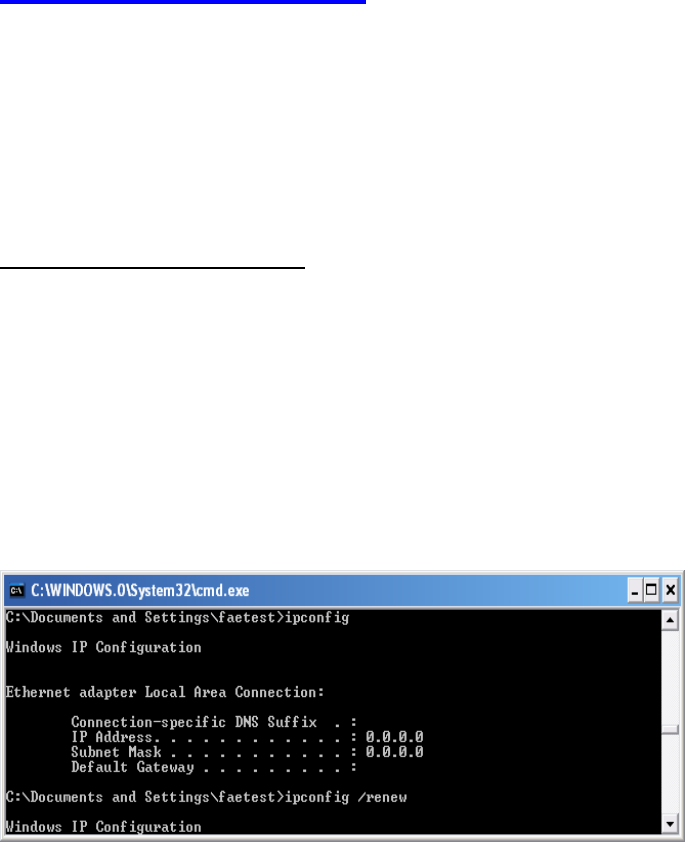
2.2 Making Connections
In order to access the MGB100 as the network storage drive or as an AP, you
may need to configure the TCP/IP settings correctly. Either the “Wired
Ethernet settings” or “Wireless Connection” can be used to connect the
MGB100 easily.
2.2.1 Check TCP/IP Settings
MGB100 will detect automatically if the DHCP server is existed, it will get a IP
address form DHCP server. If there is no DHCP server, MGB100 will assign a
random IP to client and you can get some information as below shown.
First, go to the command mode and key “ipconfig”. If the IP address and
subnet is 0.0.0.0, please key “ipconfig /renew” as follows:
14
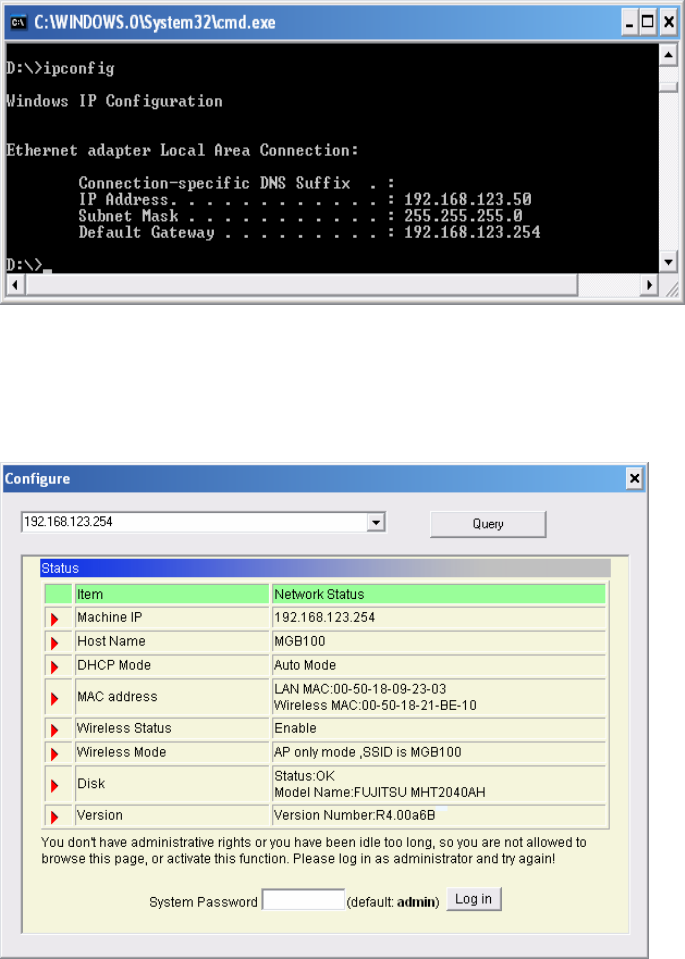
Method 1: Use Configure.exe to Setup
Then, please use the configure.exe to “Query” and you will see the status
page and input “admin” to start.
15
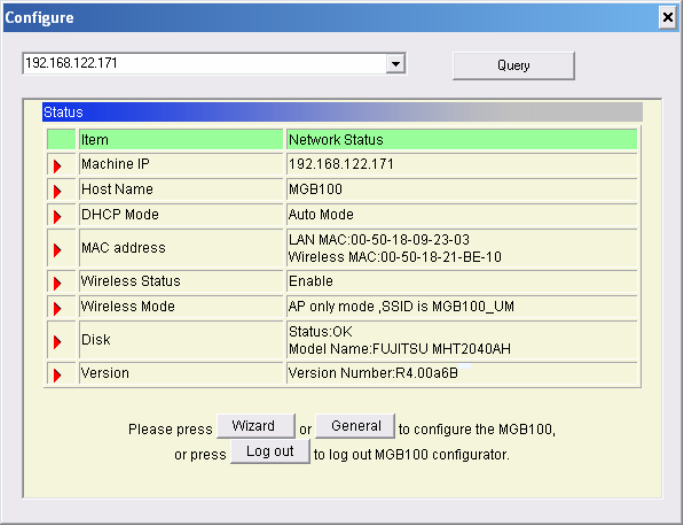
If there is a DHCP server in the network, MGB100 will be as the client and get
one IP address form DHCP server. Please use utility “configure” to Query to
start. For example, the network subnet is 192.168.122.x and MGB100 will get
a 192.168.122.171 form the DHCP server.
16
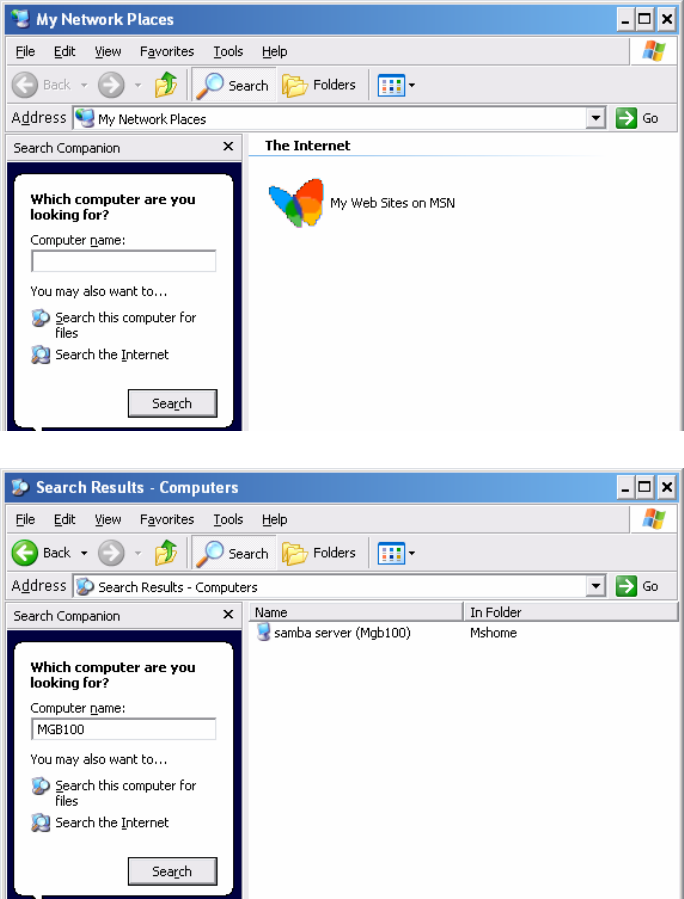
Method 2: Use “My Network Places” to Search and Setup
First, go to My Network Places and search “Computer name”.
Input “MGB100” and start to search and you will find one device.
17
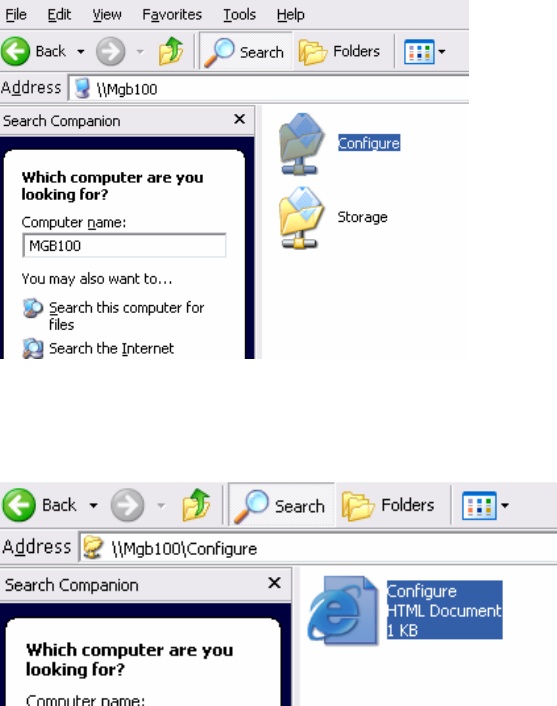
Click “samba server” and you will see two folders. Then click the folder
“Configure”.
Please click “Configure.html” directly to see configuration page.
18
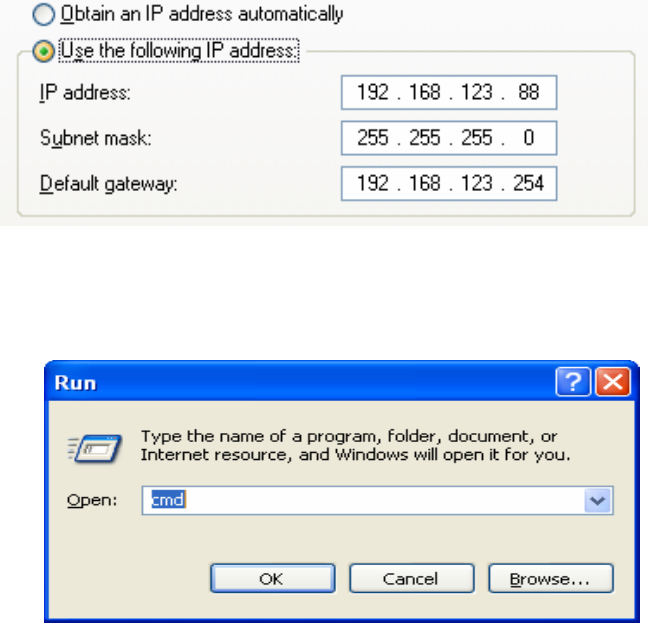
In addition, the user can allocate the IP by himself as below:
Step 1: Find the Internet Protocol (TCP/IP) Properties from the My
Network Places and check the Properties of Local Area Network
Connection. And click the “General” icon and assign one IP address which
can be from 192.168.123.1 to 192.168.123.253. Here we use the
192.168.123.88 as the IP address. The Subnet mask must be
255.255.255.0, and the Default gateway must be 192.168.123.254. Then
click “OK” button to complete TCP/IP setup.
Step2: Open the DOS command from the Start Menu->Run, and type “cmd”
then click OK.
19
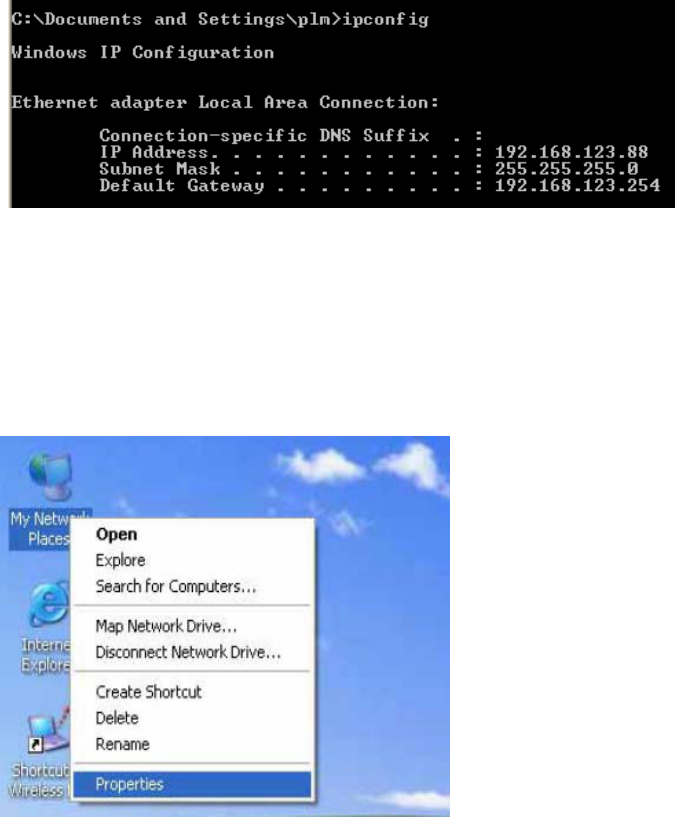
Step 3: Type the “ipconfig” and press the “Enter”. Then the following message
should be found. Check the IP address, Subnet Mask, and Default Gateway
addresses are same as previous setting. If same, you are successful to set up
the network configuration.
To install the “Client for Microsoft Networks”, “File and Printer Sharing
for Microsoft Networks”, and “Internet Protocol (TCP/IP)” as follows:
Step 1: Select the “My Network Places” on the Desktop Menu, and click the
right button of mouse to choose the “Properties”
20
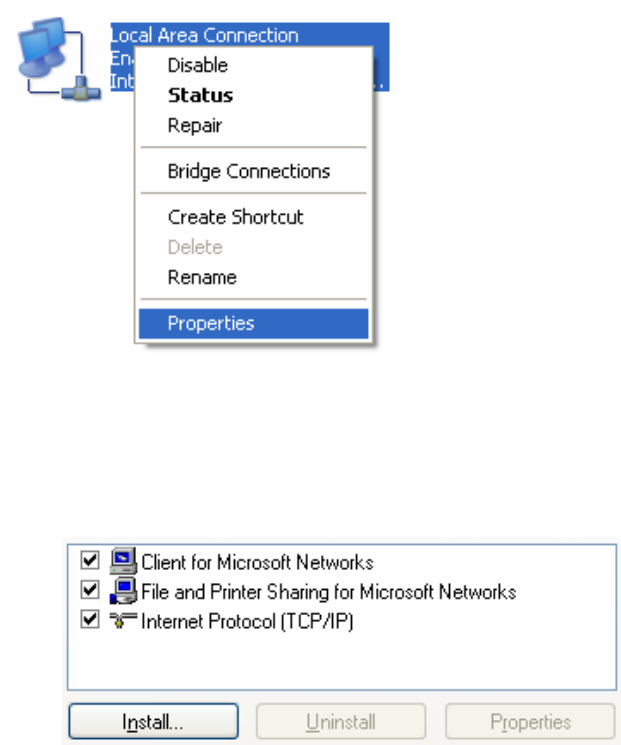
Step 2: Choose the “Properties” of Local Area Connection.
Step 3: Check the “Client for Microsoft Networks”, “File and Printer
Sharing for Microsoft Networks”, and “Internet Protocol (TCP/IP)” are
installed or not. If not, please install those communication protocols.
About other operating systems, such as Linux X-window or Mac OS. Please
use Browser to configure.
21
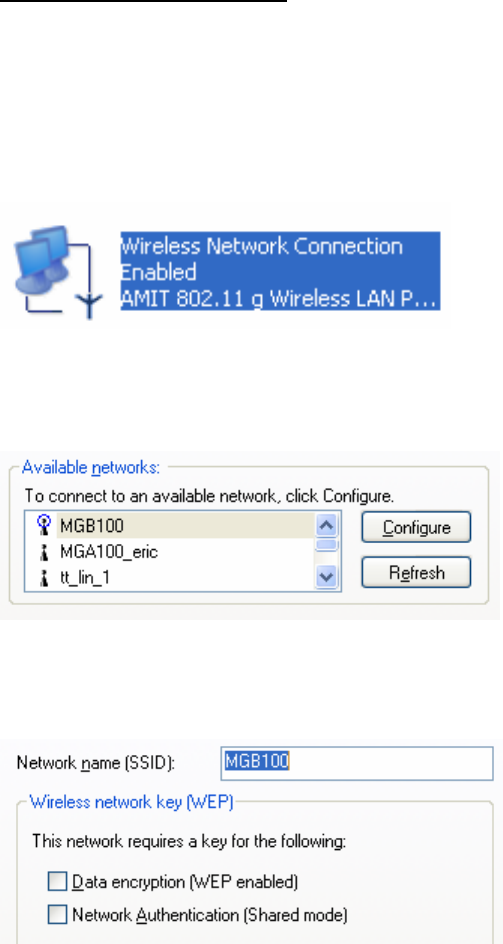
2.2.2 Wireless Connection:
Follow the steps below to connect the MGB100 in a wireless environment.
Step 1: Enabling the WLAN card first, and check the Wireless Network
Connection properties from My Network Places.
Step 2: Select the Wireless Networks icon after entering the “Wireless
Network Connection Properties”. You will find the MGB100 in the Available
networks, then select the MGB100, and click Configure to connect.
After clicking the “Configure” icon, the Network name (SSID) is supposed to
be MGB100.
22
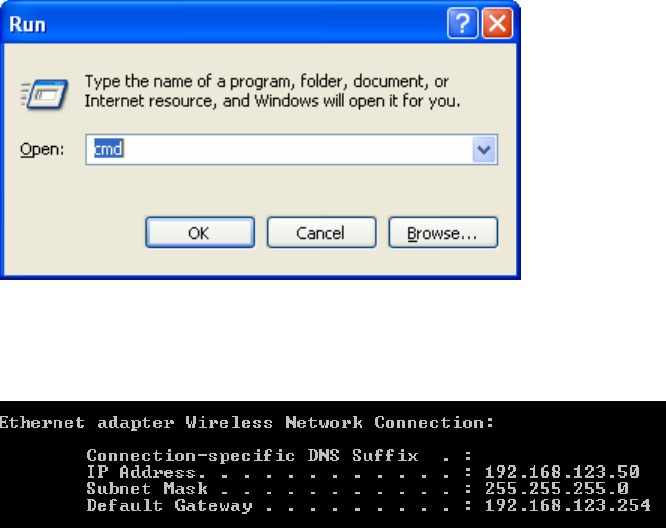
Step 3: Open the DOS command from the Start Menu->Run. Type “cmd” in
the Open folder, then click OK to enter the DOS environment.
Step 4: type the “ipconfig” and press the “Enter” in the DOS environment.
Then the following message should be found.
Check the IP address, Subnet Mask, and Default Gateway address are
same as previous settings. If same, you are successful to set up the network
configuration.
WARNING:
We strongly recommended that you enable wireless encryption feature
or add ACL rules on MGB100. Otherwise, everyone can connect to it
wirelessly and access data in your hard drive.
23
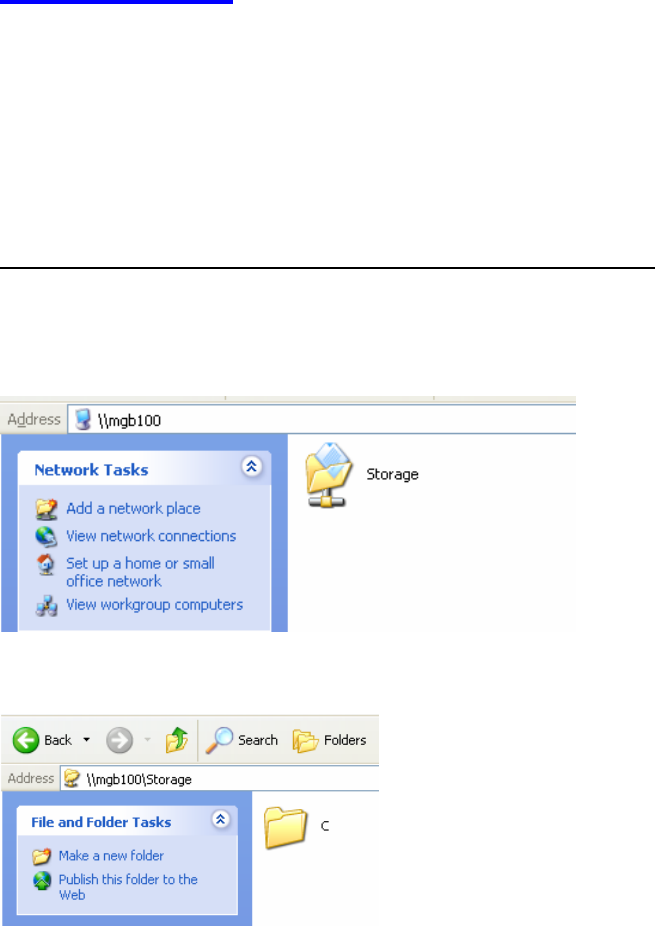
2.3 File sharing
The MGB100 can be a shared network hard drive in an existing wireless or
wired network environment. The users in the same network area can read or
write data from the device as required. The following various steps are for
users to start using the network hard drive.
2.3.1 Accessing the network hard drive via my network places
Select the “My Network Places” and type the address of “\\mgb100” and
press “Enter”, then you will find the Storage icon.
Click the “Storage” icon, and will find the C folder as below. This means you
are successfully connected to the MGB100 storage function.
24
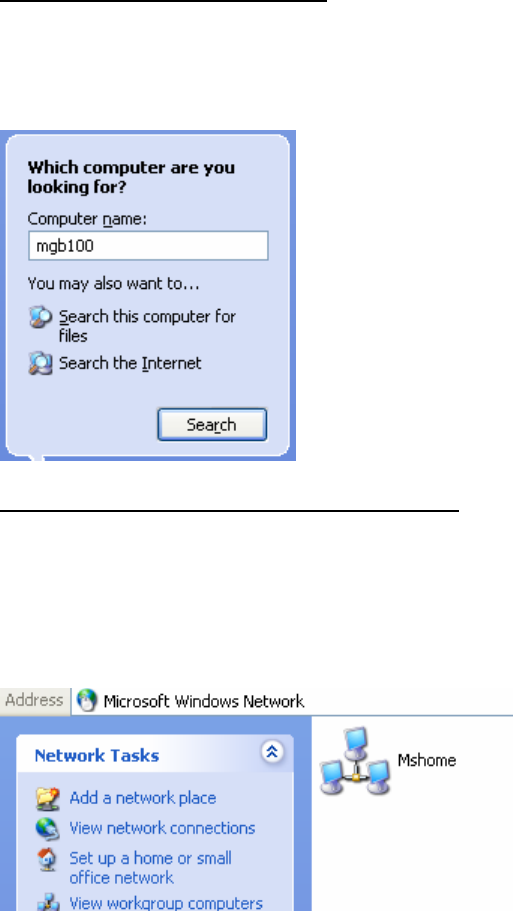
2.3.2 Searching the computers
Open “My Computer” on the desktop menu, and use the “Search” function
to search the computer of “mgb100” as below:
2.3.3 Search the “Entire Network” Manually
Open Windows Explorer, and then click the My Network Places icon.
Double click the Entire Network to view the components of the network.
Select and click the Microsoft Windows Network icon, then the various
network components showed in the list.
25

26
2.3.4 Accessing Files via FTP
MGB100 offers FTP service for the clients which don’t support Microsoft
Windows File sharing. You can use any FTP client utility to connect to
MGB100 with anonymous username and password (username: ftp, and
without password) when the permission setting is set to “Guest Only”. But if
you change to “Authorization users” mode, the accessing permission is
limited, and then users have to input specified username/password to access
any permitted folders.
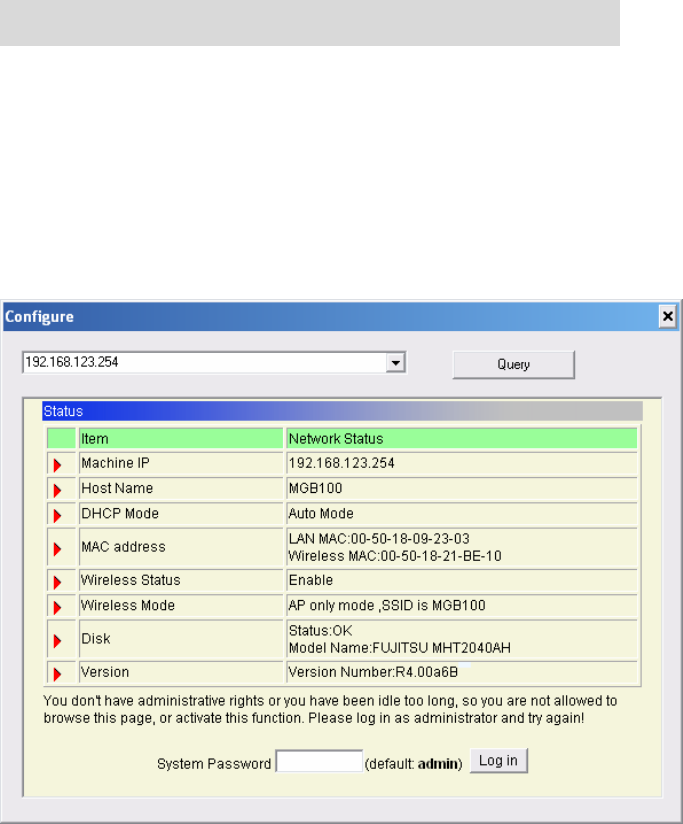
27
C
C
Ch
h
ha
a
ap
p
pt
t
te
e
er
r
r
3
3
3:
:
:
M
M
Ma
a
ak
k
ki
i
in
n
ng
g
g
C
C
Co
o
on
n
nf
f
fi
i
ig
g
gu
u
ur
r
ra
a
at
t
ti
i
io
o
on
n
n
The MGB100 can be configured various settings through the Configuration
Tool. Even you don’t know which IP is being used by MGB100, the
Configuration Tool will help you to find it. All you have to do is click the “Query”
button of the Configuration Tool.
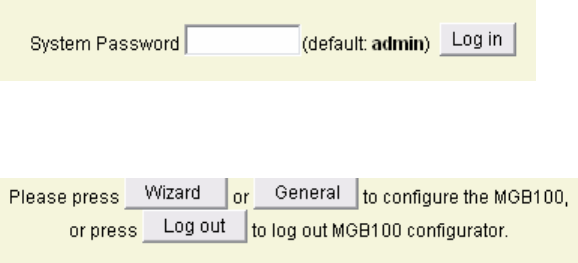
When you enter the configuration mode, you are requested to provide the
“System Password” to activate the configurations. The default authorization
password is “admin”.
After login, you could see these buttons:
Press “Wizard” if you want to do basic settings with simpler way. (Please
check chapter 3.1)
Press “General” if you want to make some advanced settings. (Please check
each item from chapter 3.2)
Press “Log out” if you don’t want to do anything.
28
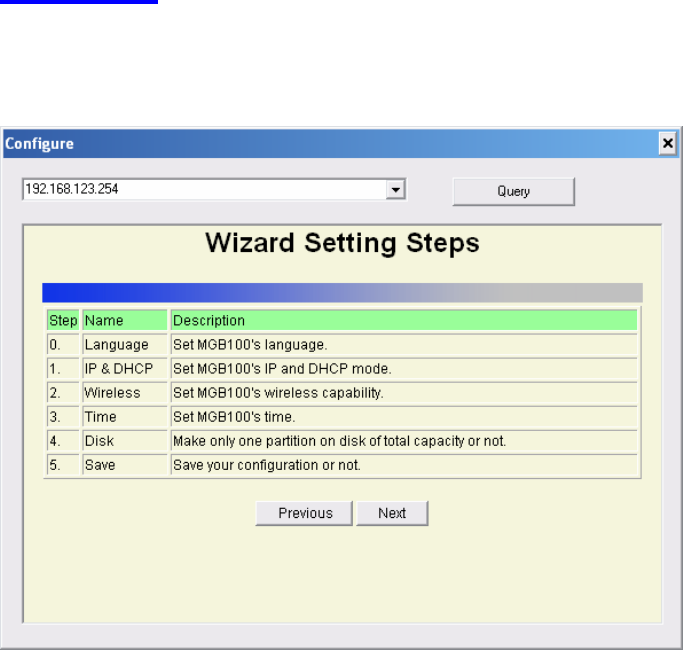
3.1 Wizard
With wizard setting steps, you could configure MGB100 in a very simple way.
Press button Next to start configuration.
29
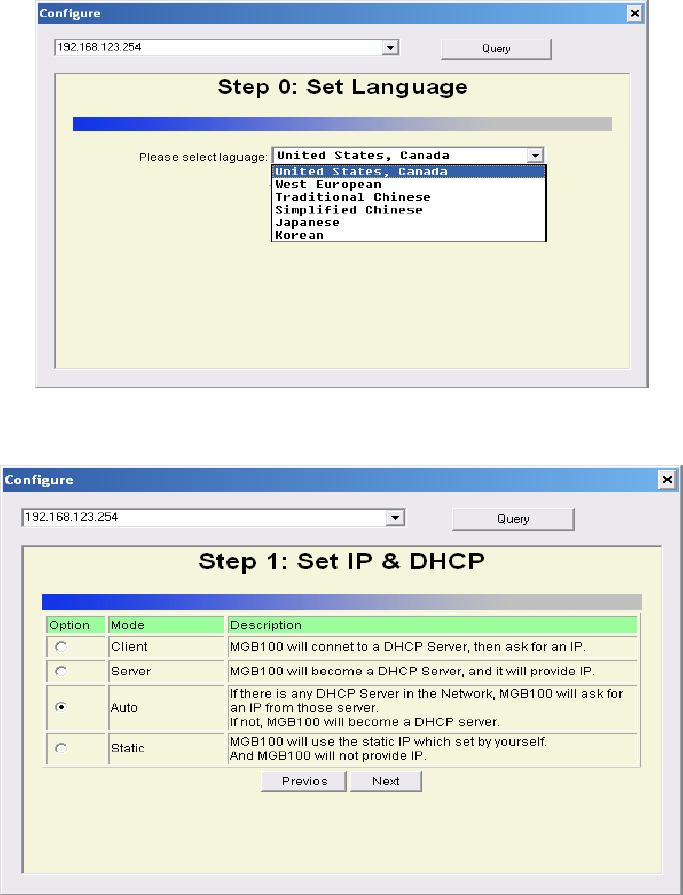
Step 0: Select Language
Step 1: You have to choose the DHCP option, default setting is Auto.
30
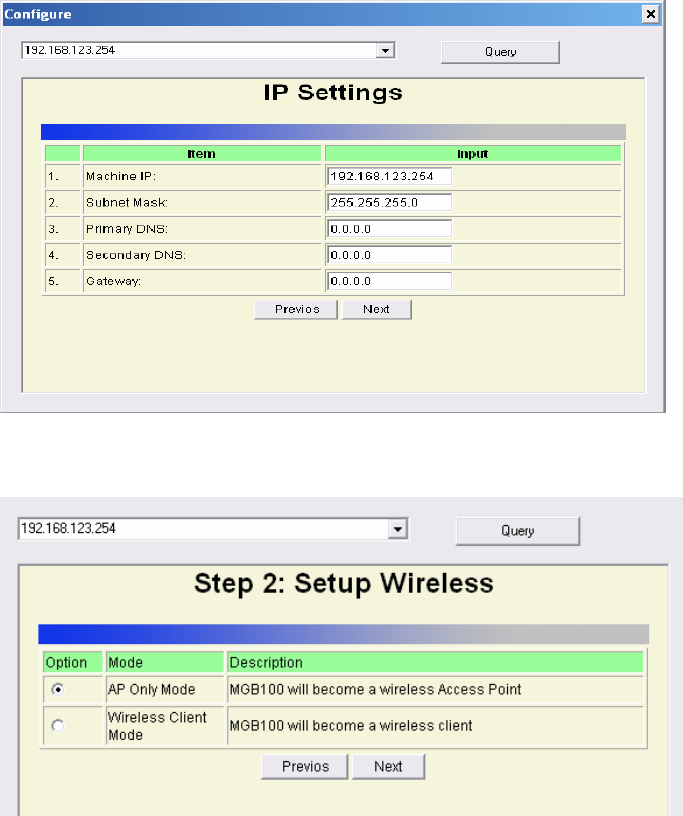
If you use Server/Auto/Static mode, you need to set some TCP/IP settings for
MGB100. If you are not sure these values, ask your MIS or ISP.
Step 2: You have to choose the Wireless mode, default setting is AP Only
Mode.
31
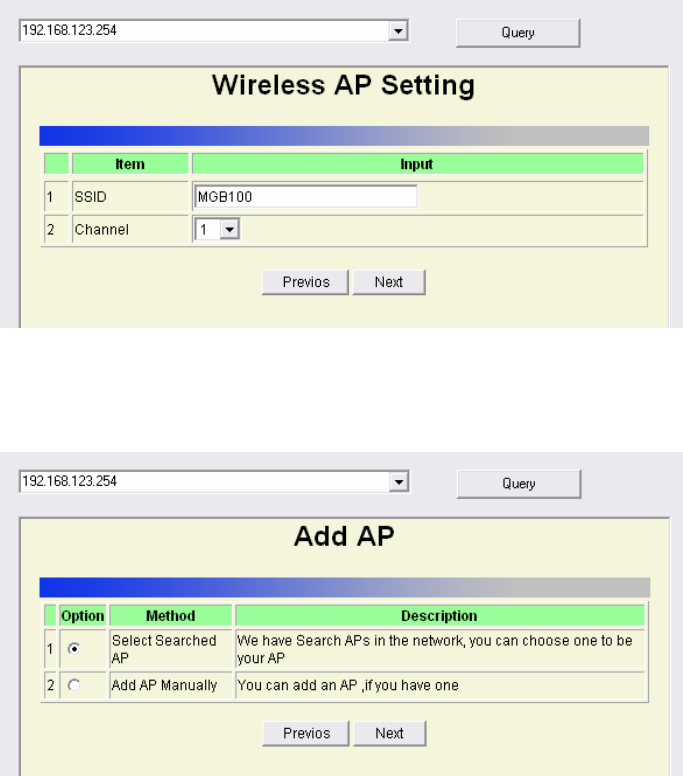
If you choose to use AP Only Mode, in next page, you could specify the SSID
and the wireless channel number for MGB100.
If you select the Wireless Client Mode, in next page, you would have to
specify the AP that you want MGB100 to connect to.
32
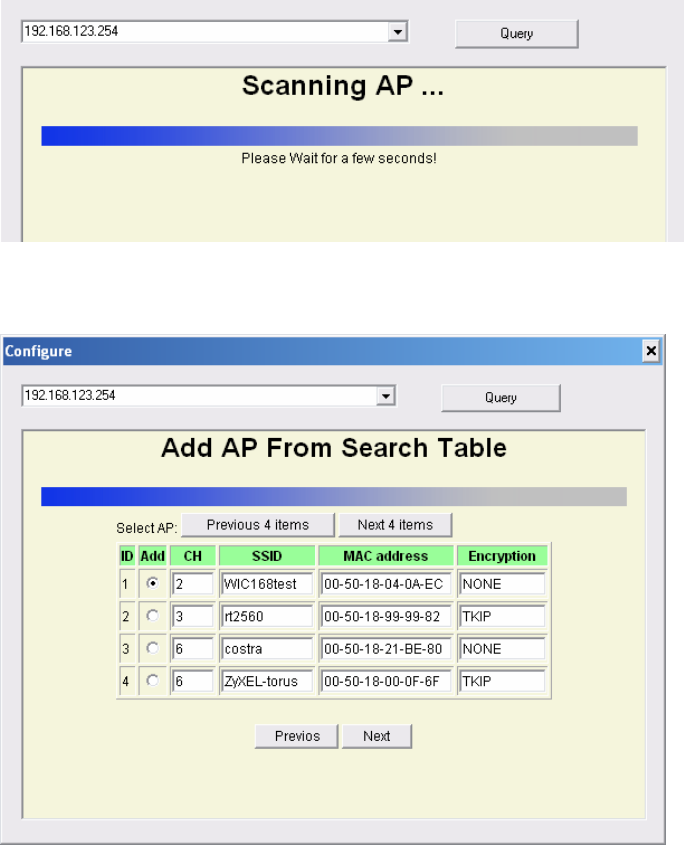
You have two ways to do this job. One is searching the AP that MGB100 could
get.
In this page, you could select the AP you want MGB100 to connect with.
33
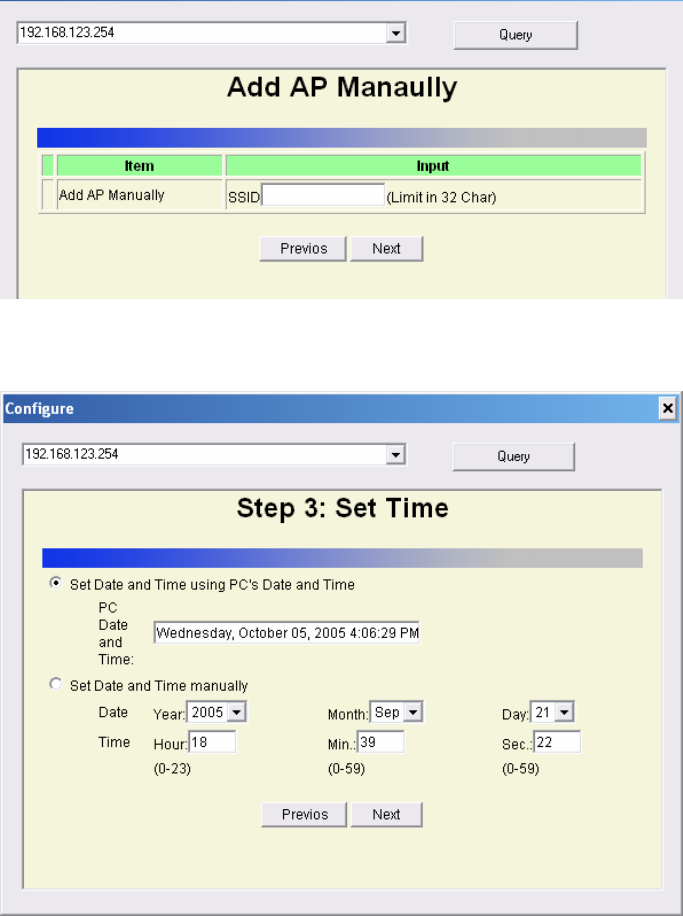
The other way to add an AP is adding the SSID manually.
Step 3: You have two ways to set time for MGB100. You could sync time with
your PC, or set time manually.
34
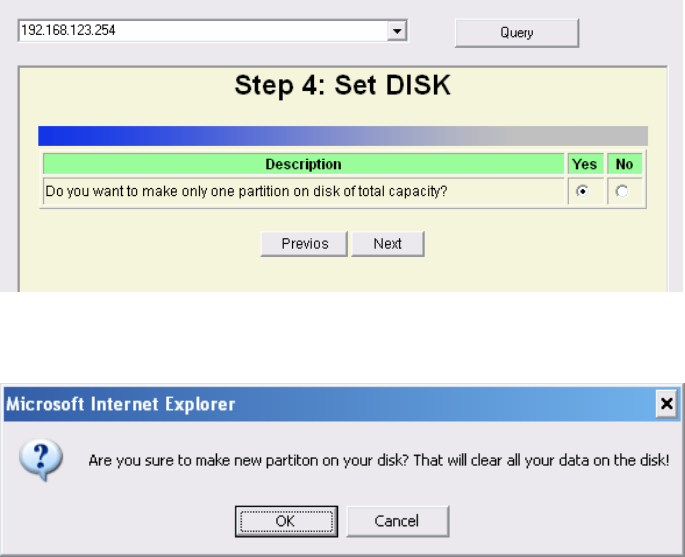
Step 4: If you use a whole new hard disk, please select “Yes”. If you already
have data in this hard disk, you might want to select “No”. This option would
format your hard disk to one partition if you select “Yes”.
To confirm your decision, MGB100 would ask you one more time.
35
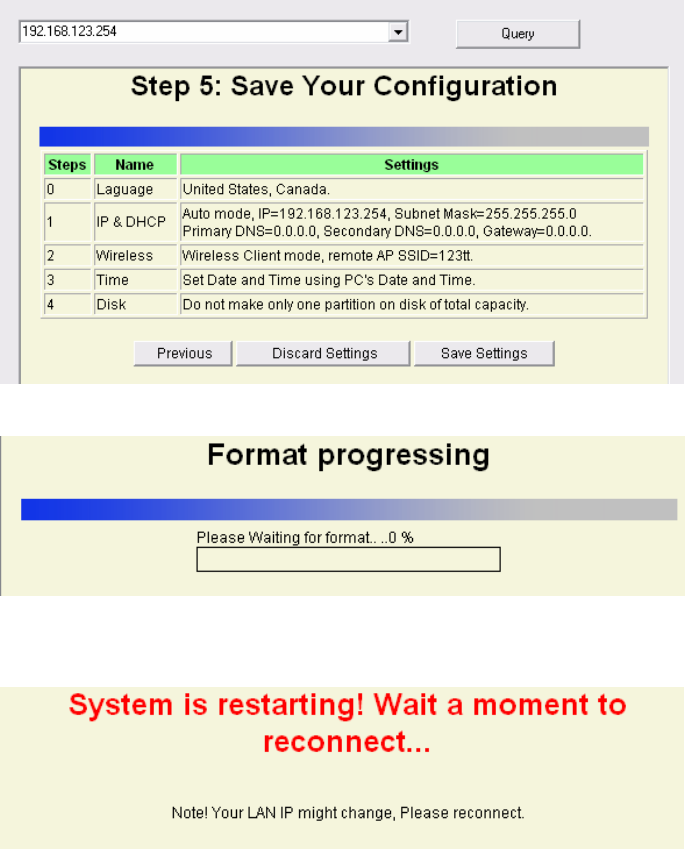
Step 5: Check your settings again before saving. Click “Discard Settings” and
you could return the first page. If you want to change any setting, please click
“Previous” button. If everything is okay, click “Save Settings”.
If you need to format disk, please wait the progressing bar become 100%.
After all done, system would reboot automatically. Please wait 30 seconds at
least for system restarting.
36
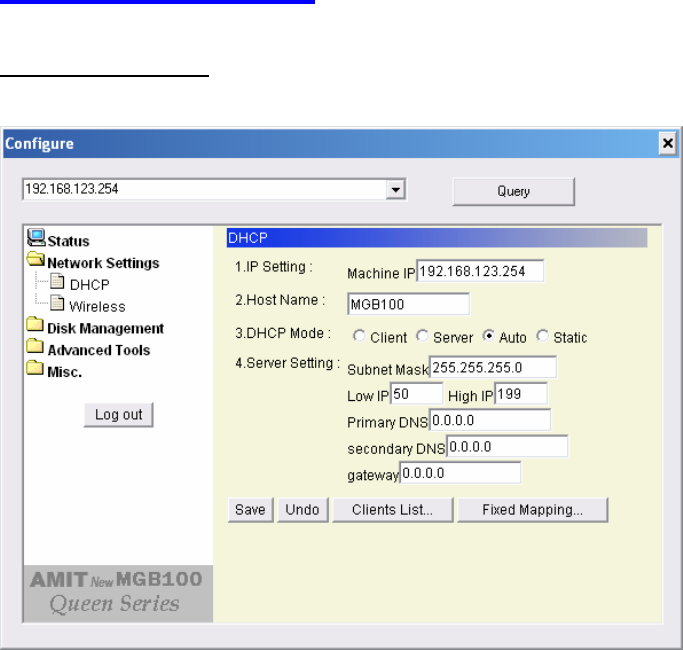
3.2 Network Settings
3.2.1 DHCP Setting
Following sections describe the various DHCP settings.
z IP Settings: default machine IP is 192.168.123.254. This IP
address must be unique to your network. You can change if
necessary. This setting is only used for DHCP server mode, and
Static IP mode.
z DCHP Mode: The default mode is “Auto”
9 Client: If you have a DHCP server on the network, set this
37
38
option to receive an automatic IP address and subnet mask
assignment.
9 Server: The MGB100 will be a DHCP server on the network.
9 Auto: Select this option to let MGB100 send out a DCHP
request during boot up. If you have a DHCP server on the
network, the MGB100 will receive an automatic IP address
and subnet mask assignment. If no DHCP server on the
network, the MGB100 will be a DHCP server on the network.
9 Static: You can manually configure the IP address and subnet
mask.
z Server Setting:
9 Subnet Mask
9 Low IP and High IP: decide the IP address range that DHCP
server could offer.
9 Primary DNS / Secondary DNS: This feature allows you to
assign DNS Servers. You could get this information from your
ISP.
9 Gateway: The gateway IP address would be the IP address
of an alternate Gateway. If you do not know how to set up the
Gateway, leave this option blank.
9 Client List: When MGB100 is as a DHCP server, here will
show some information of DHCP client.
9 Fixed Mapping: DHCP server can assign the same IP
address to a certain “MAC address”.
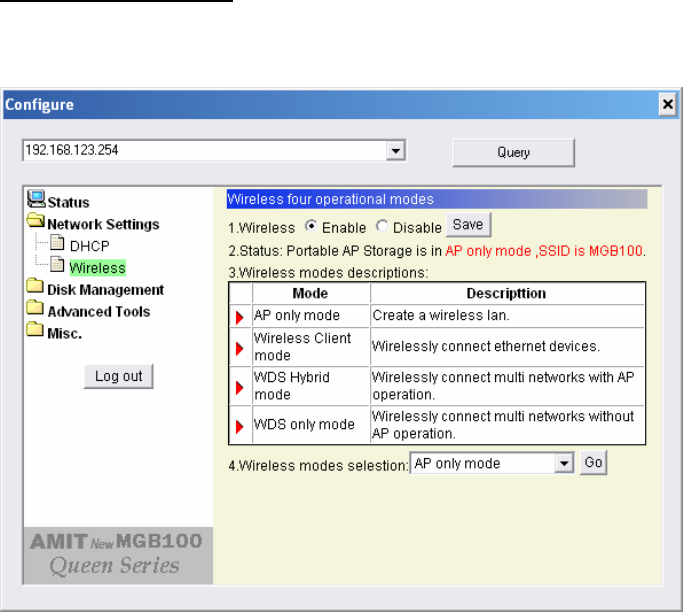
3.2.2 Wireless Setting
Select the Wireless option in the configuration mode.
Followings information will let you know the current wireless operation status.
z Wireless: you can select “Enable” or “Disable” the wireless
function.
z Status: to show the current wireless mode you are using.
z Wireless mode description: to describe the each wireless mode’s
major function.
z Wireless modes selection: MGB100 provides four wireless modes to
select.
39
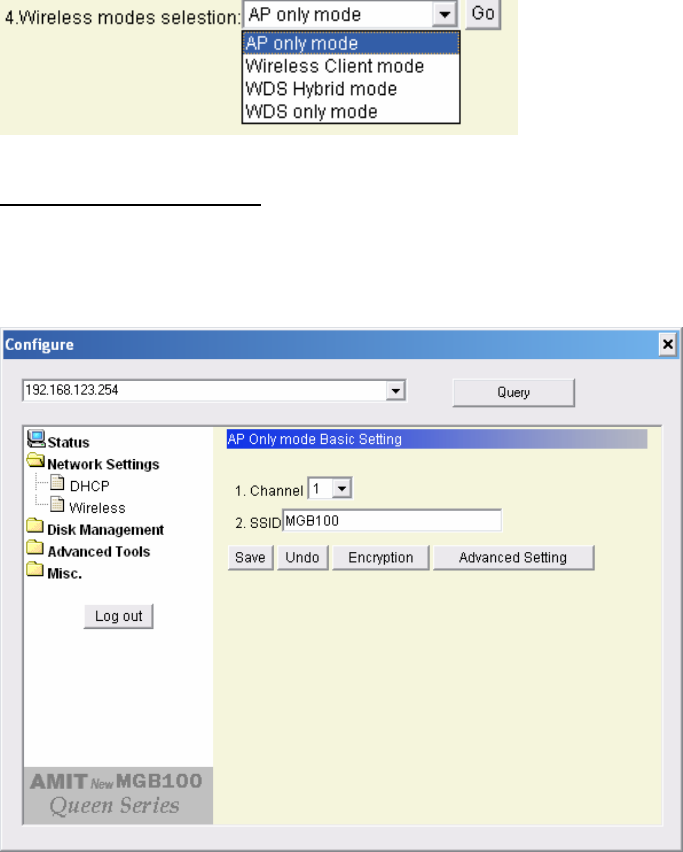
Choose the wireless mode you need and click “Go” to set up detail functions.
3.2.2.1 Wireless AP only
When you are in the AP only mode, you can set up the basic wireless
functions as below:
40
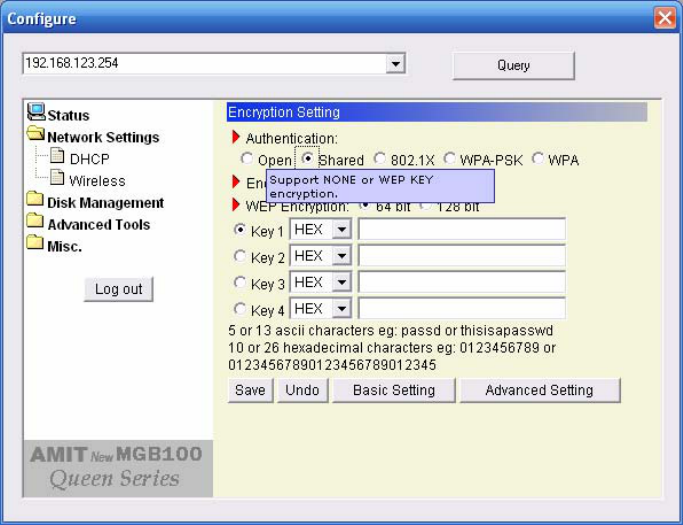
AP setting:
z SSID: The SSID identifies a specific wireless LAN. Before associating
with a particular wireless LAN, a station must have the same SSID as
the access point. The default SSID setting is “MGB100”. NOTE:
Please DO NOT set the same SSID with your current wireless
network.
z Channel: The radio channel number. The default channel is “6”.
NOTE: Please DO NOT set the same Channel with your current
wireless network.
z Authentication: Authentication ensures that digital data transmissions
are delivered to the intended receiver. This option enables you to set
41
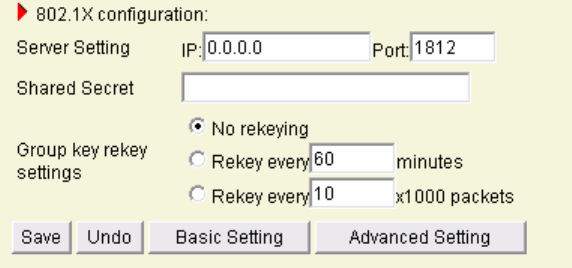
the authentication method for various encryption schemes for the
selected AP.
z Open or shared WEP Encryption: Select “64” or “128” bits in the
pull-down menu for encryption method to protect your data by
encrypting it. The WEP key can be 5~13 ASII characters or 10~26
hexadecimal characters based on whether you select 64 bit or 128 bit
WEP encryption.
z 802.1X: IEEE802.1x authentication can be done by using an external
RADIUS server.
Please input the IP address of RADIUS server and Shared Secret.
Please refer to FAQ in Chapter 7 to get more detailed information.
z WPA-PSK: AP and Client need to use identical Pre-shared key (PSK).
Please input 64 Hex key (0~F) or 8~63 characters in ASCII Type.
Note. This device only supports WPA version 1.
z WPA: WPA applies IEEE802.1x and Extensible Authentication
Protocol (EAP) to authenticate wireless clients using an external
RADIUS server.
42
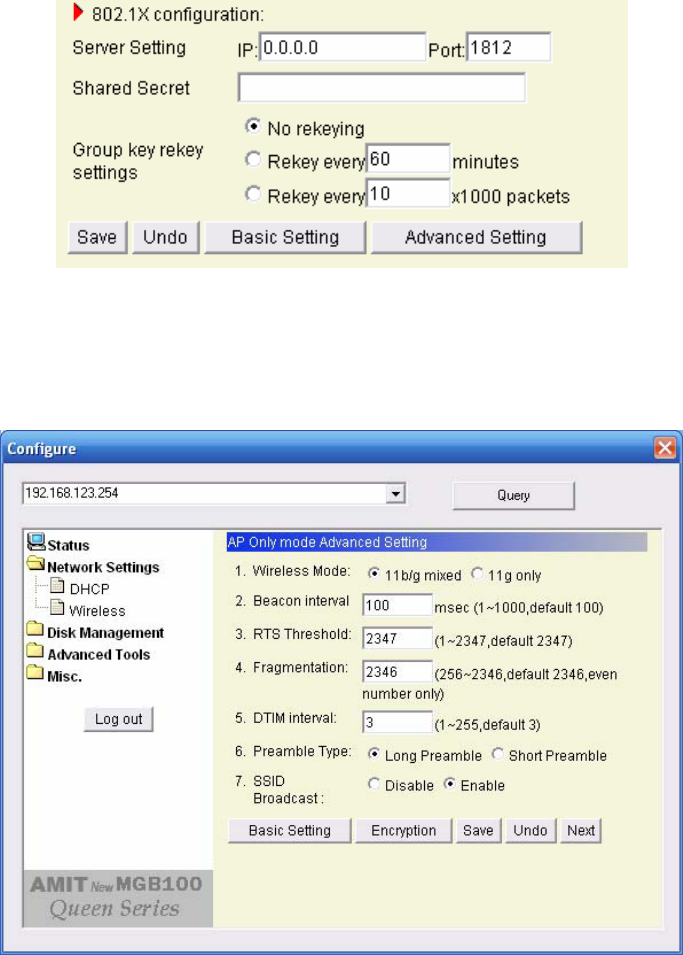
Please input the IP address of RADIUS and Shared Secret.
Please refer to FAQ in Chapter 7 to get more detailed information.
Advance Setting:
43
44
z Wireless mode: 11b/g mixed can let 11g or 11b computers both exist
on the network, but the speed will be reduced. Select 11g only for
maximum speed, but no 11b users will be allowed on the network.
z Beacon interval: This represents the amount of time between beacon
transmissions. The interval tells receiving devices on the network
how long they can wait in low-power mode before waking up to
handle the beacon. Beacons are packets sent by an Access Point to
synchronize a wireless network. Specify a Beacon interval value
between 1 and 1000. The default value is set to 100 milliseconds.
z RTS Threshold: The RTS threshold specifies the packet size of an
RTS transmission. This helps control traffic flow through an access
point, especially one with many clients. The setting value range is
from 1 to 2347, and default value is set to 2347.
z Fragmentation: In a network, the maximum size or length of a
fragment is determined by the protocol used to transport the data.
This value should remain at its default setting of 2346. If you
experience a high packet error rate, you may slightly increase your
"Fragmentation" value within the value range of 256 to 2346, even
number only. Setting the Fragmentation value too low may result in
poor performance.
z DTM interval: A Delivery Traffic Indication Message (DTIM) is a
countdown informing clients of the next window for listening to
broadcast and multicast messages. When the Access Point has
buffered broadcast or multicast messages for associated clients, it
sends the next DTIM with a DTIM Interval value. AP clients hear the
beacons and awaken to receive the broadcast and multicast
messages. Enter a value from 1 to 255 for DTIM. The default value
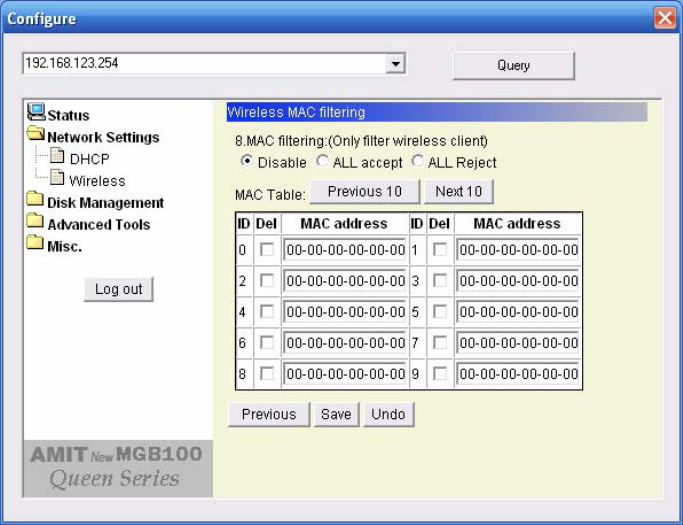
for DTIM interval is set to 3.
z Preamble Type: The Preamble Type defines the length of the CRC
(Cyclic Redundancy Check) block for communication between the
Access Point and roaming wireless adapters.
z SSID Broadcast: Enable or Disable a SSID broadcast. When
enabled, the SSID of MGB100 is sent to wireless enabled devices on
the LAN.
Press “Next” button, you could see the Wireless MAC Filtering setting.
The default setting is “Disable Mac filtering”, every wireless client could
connect to this AP. When you select “ALL accept”, the wireless clients with
45
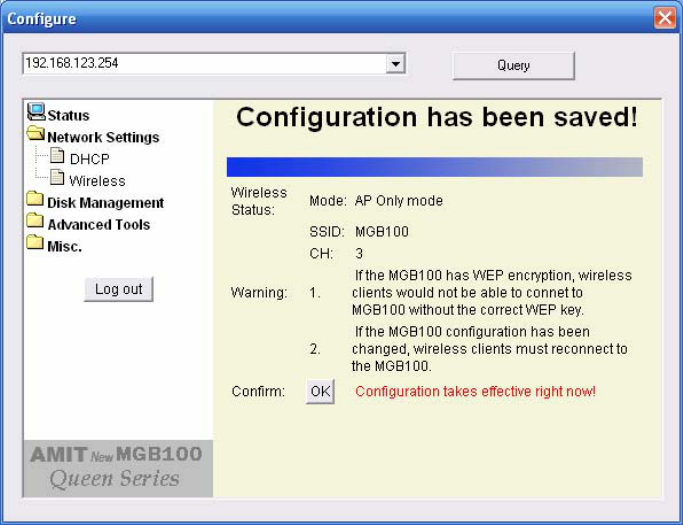
the MAC addresses you enter bellow will be accepted to connect to this AP,
the others will be rejected. When you select “ALL Reject”, the wireless clients
with the MAC addresses you enter bellow will be rejected to connect to this
AP, the others will be accepted.
After press “Save” button, MGB100 would show you this page about the
wireless settings you have done.
46
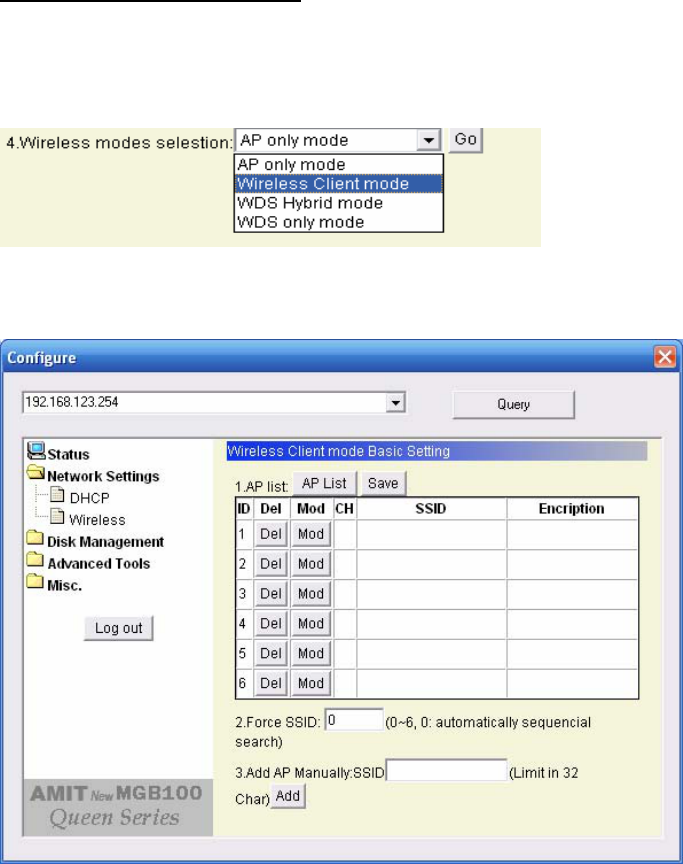
3.2.2.2 Wireless client mode
Select the “Wireless client mode” and click “Go” to set up under the
Wireless client mode.
After entering the Wireless client mode setting, click the AP List icon to set up
the AP connecting list.
47
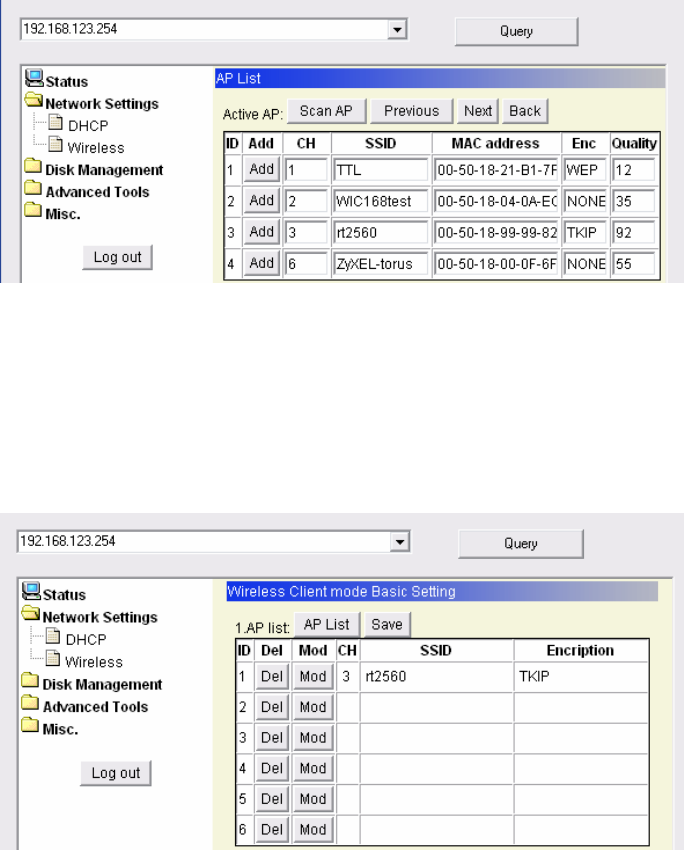
Click the “Scan AP” to scan the existing AP list. Select the AP you want to
connect and click “Add” to set up the AP list.
Select the AP you want to connect and click “Add” to set up the AP list.
Click “Mod” to specify the AP information. After clicking the “Mod” button, you
will find the following information and modify it depending on your actual
wireless environment; this should be done necessarily when you are in the
secured wireless network with WEP.
48
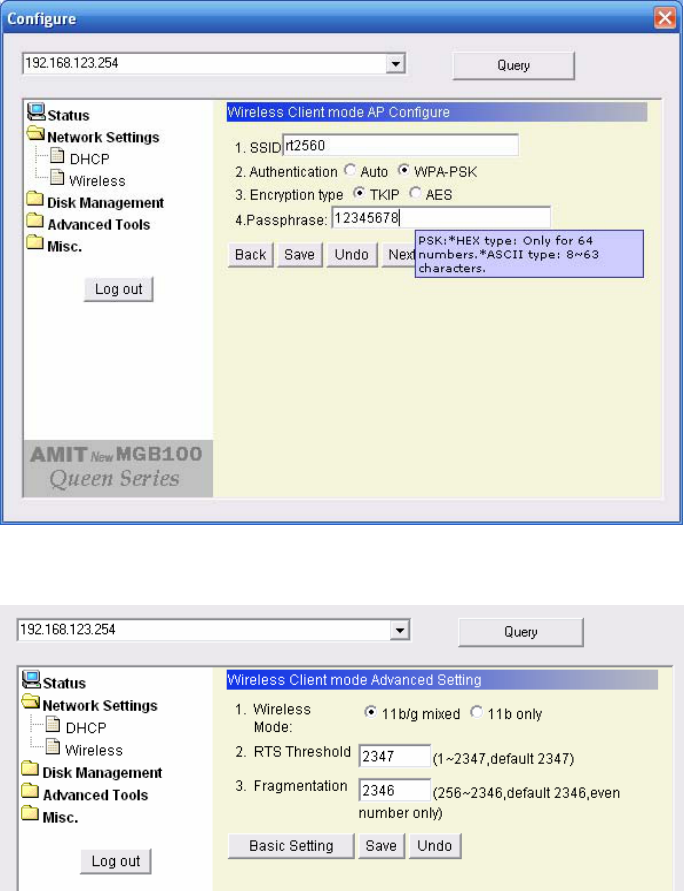
Click the “Next” for advanced setting, or click “Save” or “Undo” for your
need.
The advanced setting items are shown as below:
49
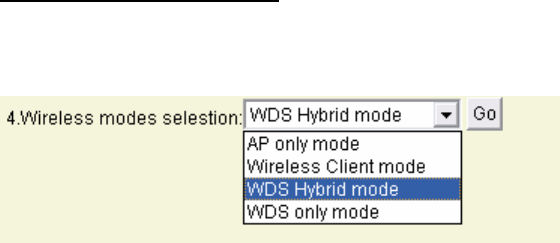
For the meanings of above items, please refer to “Advanced setting”.
After saving the values of client mode, you have to go back the “Wireless
Client mode Basic Setting” page and click “Save” on the top of the page. Then
you could check the settings that you have done.
3.2.2.3 WDS Hybrid mode
Select the “WDS Hybrid mode” and click “Go” to set up
After entering the WDS Hybrid mode setting, click the AP List icon to set up
the AP connecting list. Then click the “AP Setting” icon and set up the AP.
50
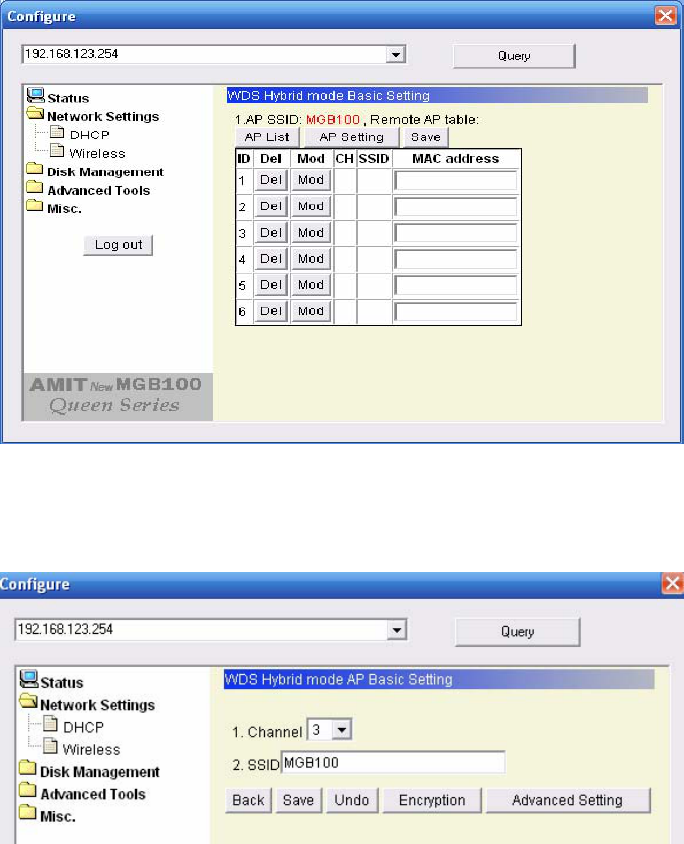
NOTE: You MUST use the same channel with the AP you want to bridge. In
this example, we set the channel to 10.
Click the Advanced Setting icon, and you could set more values. About the
meanings of these please refer to 3.2.2.1.
51
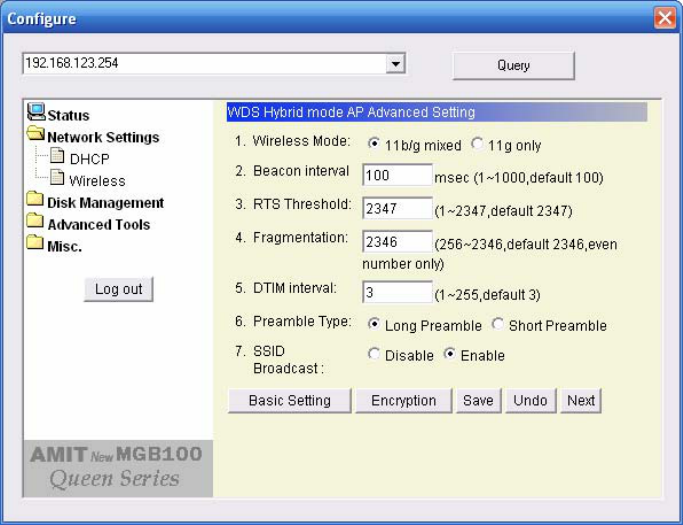
Go back to Basic Setting, and click “Save”.
If everything goes fine, you could see the confirm page, and let you know
configurations have been saved.
52
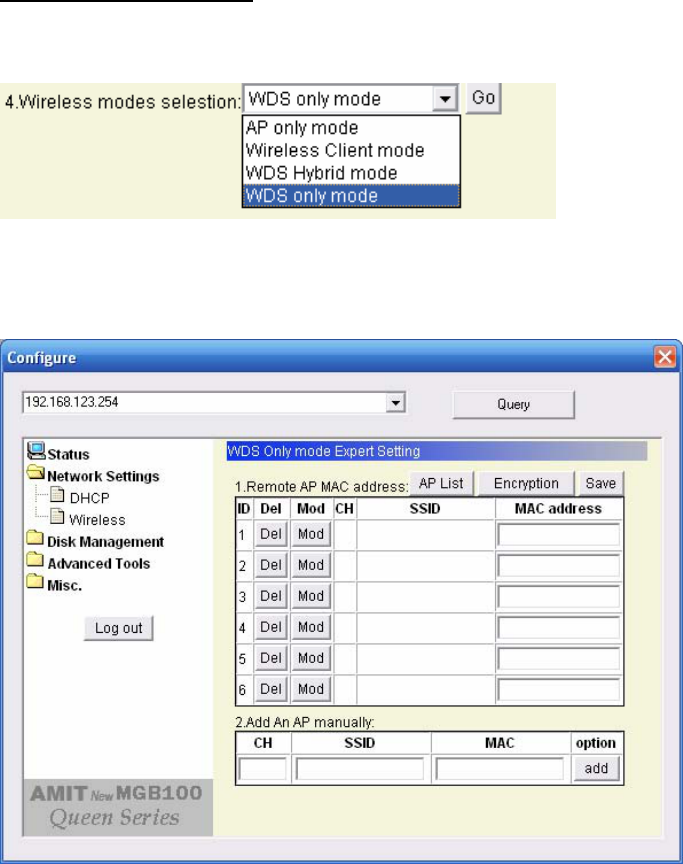
3.2.2.4 WDS only mode
Select the “WDS only mode” and click “Go” to set up.
After entering the WDS only mode setting, click the AP List icon to set up the
AP connecting list, or add it manually.
53
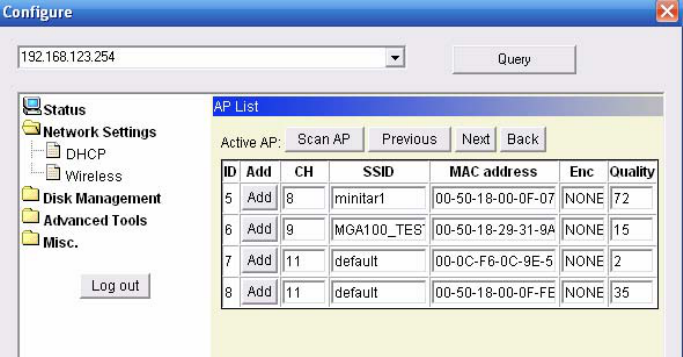
NOTE: In WDS only mode, each AP that bridged together MUST use the
same channel.
After all, click “Save” to make it work.
NOTE: Each WDS device MUST set the others’ MAC addresses, or the WDS
mode would be failed.
54
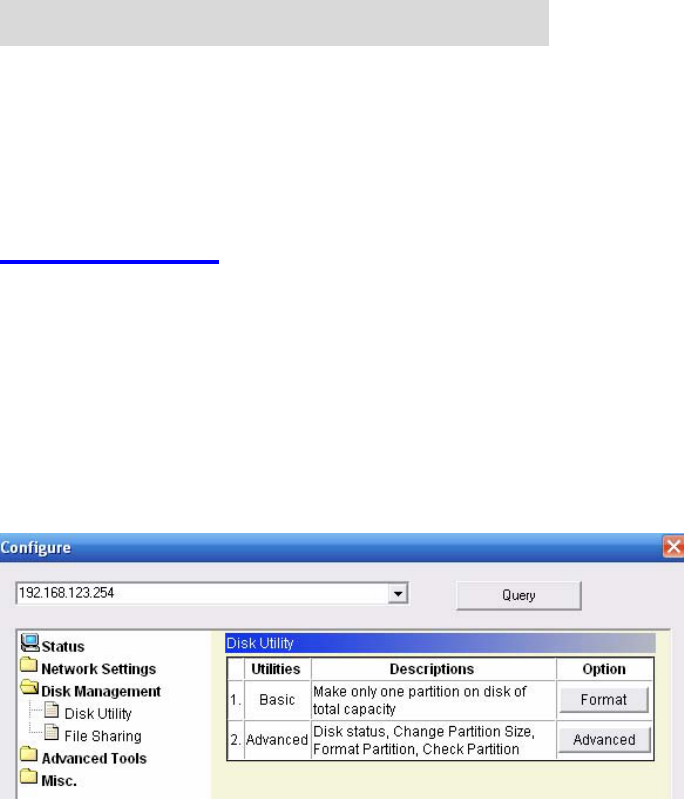
55
C
C
Ch
h
ha
a
ap
p
pt
t
te
e
er
r
r
4
4
4:
:
:
D
D
Di
i
is
s
sk
k
k
M
M
Ma
a
an
n
na
a
ag
g
ge
e
em
m
me
e
en
n
nt
t
t
In this section, you will know how to use the “Disk Management” tools to
configure the hard disk setting.
4.1 Disk Utility
Before using the hard disk, users need to format this hard disk first. Click
“Format” button, and the MGB100 will start to format the hard disk
automatically. Once finishing the format, the MGB100 will reboot automatically,
and please reconnect the network in 30 seconds.
The Hard disk will be formatted as “ext2” file system.
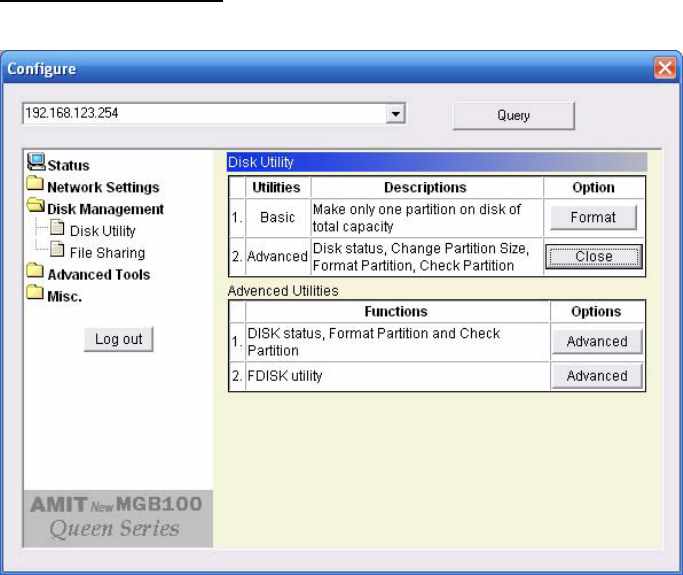
Advanced Function
In the advanced function, two more options will be shown:
The first option is used for disk checking. If you power off MGB100 before
normally shut down the system, you are recommended to do this. With
second option, you could partition your hard disk to the size you want.
Total Disk Capacity: to indicate the total capacity of the hard disk. This page
shows the partitions of internal hard disk, you could format/check one of them.
56
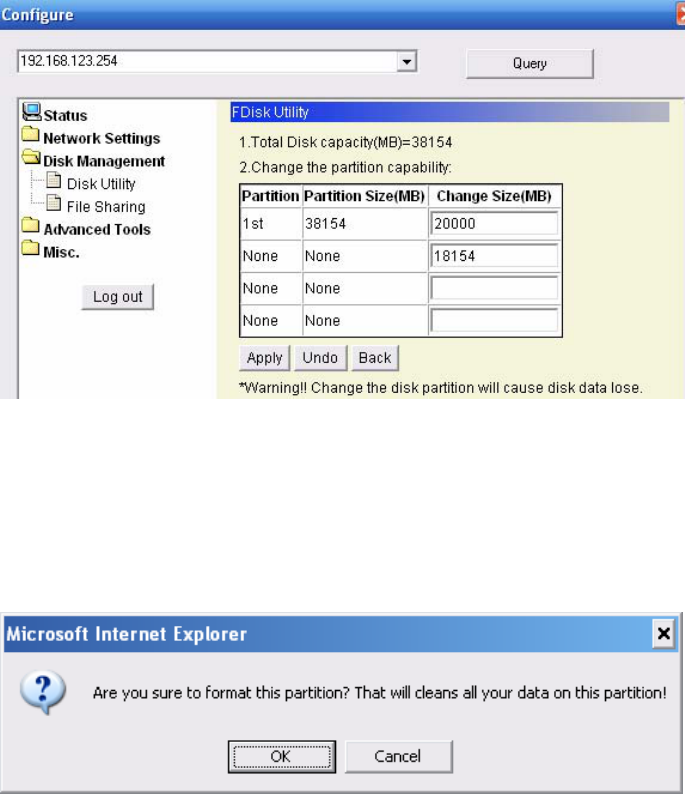
Change the partition capacity: this tool can make you create up to four
partitions. Specify the size of the partitions in megabytes and click the
“Apply” to apply the new settings.
When you click “Apply”, system would alert this message to confirm if you
really want to do the format action.
Warnings:
Any data in the hard disk will be lost after creating the new partitions.
The hard disk is formatted to EXT2 file system. It can not be connected
directly to a Microsoft Windows system without reformatting.
57

58
C
C
Ch
h
ha
a
ap
p
pt
t
te
e
er
r
r
5
5
5:
:
:
A
A
AD
D
DV
V
VA
A
AN
N
NC
C
CE
E
ED
D
D
F
F
FU
U
UN
N
NC
C
CT
T
TI
I
IO
O
ON
N
NS
S
S
Click the Advanced Functions option on the left panel to display its
submenus. The Advanced Functions menus enable you to configure the
various system settings. Refer to the following sections for more details.
5.1 Config Backup
This option enables you to back up your settings. Once you want to restore
these settings, please click the F/W Upgrade option and use the bin file you
saved.
5.2 Reset to Default
This option enables you to reset the MGB100 to its default factory settings.
5.3 Reboot
This option enables you to reboot the device.
5.4 F/W Upgrade
This option enables you upgrade the new firmware to this product
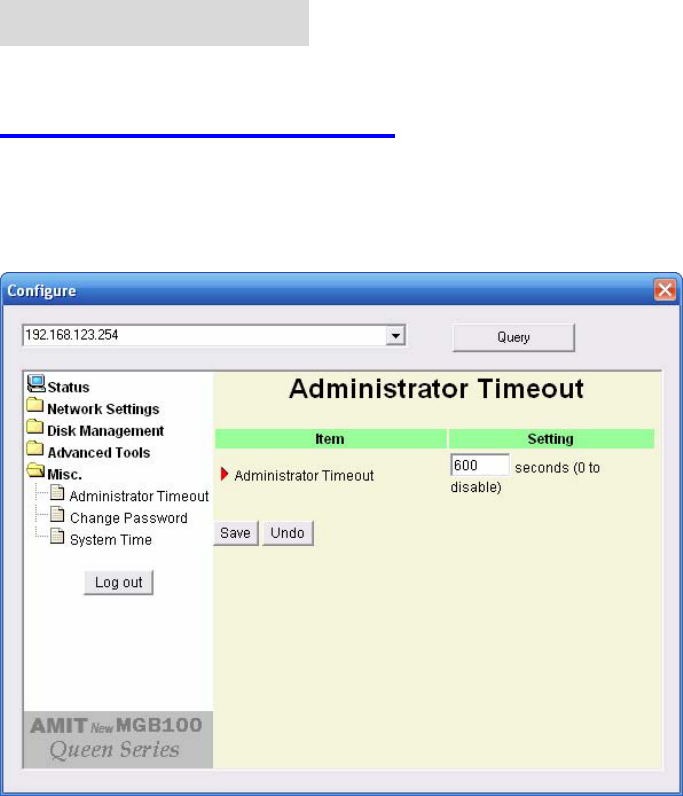
59
C
C
Ch
h
ha
a
ap
p
pt
t
te
e
er
r
r
6
6
6:
:
:
M
M
MI
I
IS
S
SC
C
C
6.1 Administrator Timeout
If users login, and idles for a period of time (e.g. 600 seconds), then that user
will be logged out automatically.
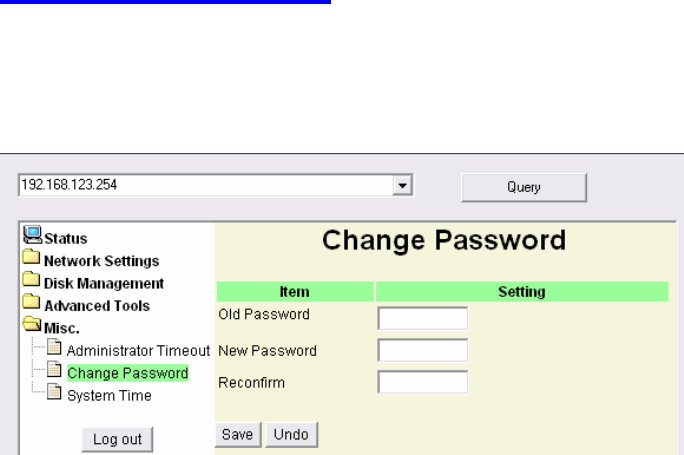
6.2 Change Password
To change the password, you have to enter the old password and confirm the
new password twice.
60
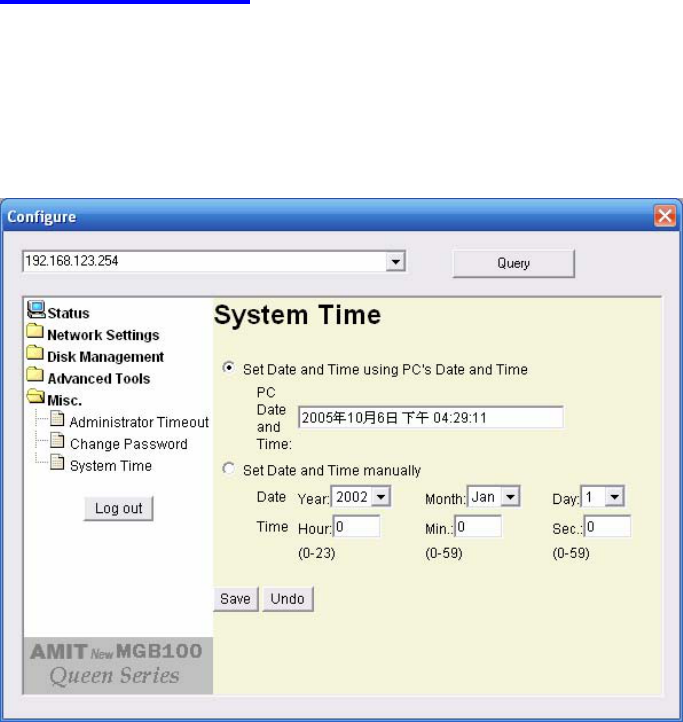
6.3 System Time
The System Time provides two options for you to select.
Set Date and Time using PC’s Date and Time: synchronize the date and
time with the computer.
Set Date and Time manually: Manually setting up the date and time.
61

62
C
C
Ch
h
ha
a
ap
p
pt
t
te
e
er
r
r
7
7
7:
:
:
T
T
Tr
r
ro
o
ou
u
ub
b
bl
l
le
e
e
S
S
Sh
h
ho
o
oo
o
ot
t
ti
i
in
n
ng
g
gs
s
s
What can I do when I have some trouble in the first time?
1. How do I make the client to connect the MGB100?
A: Please prepare for one RJ45 cable and connect the LAN port directly.
MGB100 already supports MDI/MDIX.
2. How to “Reset to default”?
A: Press the buttons of “Shutdown” and “Backup” simultaneously over 6
seconds to reset the system to the factory default setting.
3. When I login the storage of MGB100 via my network place, but I can
not find any files of Folders even if I have plugged HDD in MGB100.
A: First, check your HD status LED. If the HD is correctly connected, the HD
status LED will flash. If the LED didn’t flash, maybe you forget to format
the new HD before using it, or maybe the HD is not connected correctly,
or maybe the HD is corrupted.
® MGB100 supports FAT/FAT32/EXT2 file systems. If the format of HDD
is NTFS, the device just can read files and can not copy any files to NTFS
folders.
4. No matter what I do, I can not configure MGB100 even if I setup fixed
IP and can search or Ping MGB100.
A: Please check the WLAN Led or HDD LED. If normal, they will be flash.
Otherwise Reset to Default and try it again.
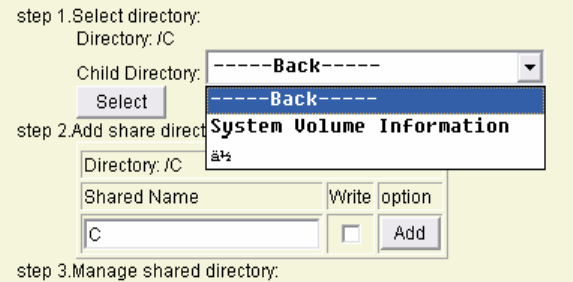
5. I can not save the file which size is large than 2GB.
A: Please check the file system of your HDD. If it is FAT or FAT32. This
problem is existed. Suggestion: To convert to ext2.
6. I can’t access the shared folder with 98/Me.
A: If you use Windows 98/Me, and want to access the authorized folder, you
MUST have the same account and password in MGB100 and your
computer.
7. Why do I see the wrong name of file during the setting or in the my
network place?
A: Please select the language as you need. Please configure again.
63
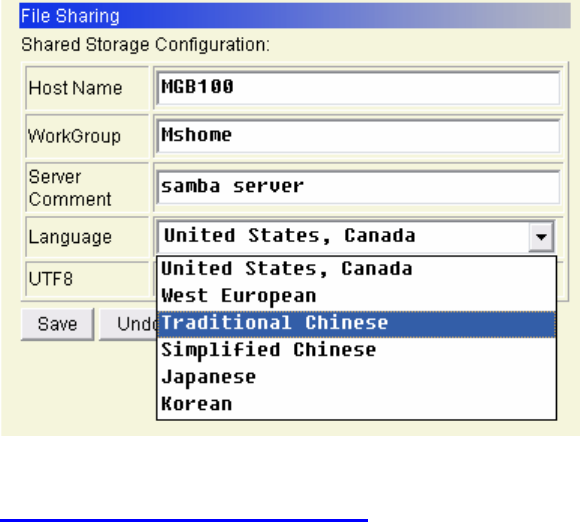
How to setup wireless function?
1. How can I use the wireless function?
A: Generally speaking, there are four modes to setup in this device. The
common function is “AP mode”. The user can make this device as
Wireless AP device as follows:
First, the wireless client sets up the same SSID with MGB100 and get IP
from Router. Then Wireless client can associate the network or roam
Internet via Router.
64
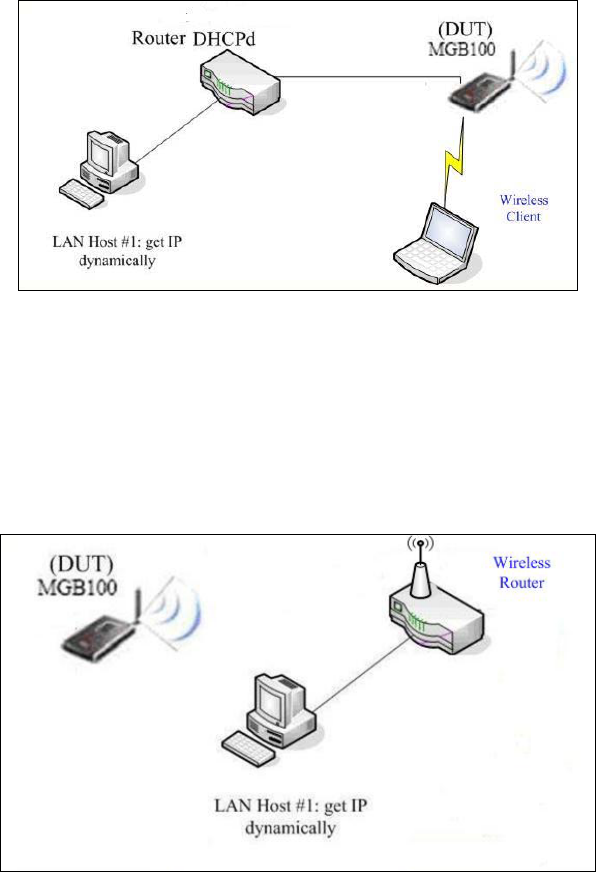
Wireless Client Mode: First, please configure the wireless setting of
MGB100 via wire. Then use Scan AP of AP-List and join it. Plug up the
cable form MGB100. The client from LAN can use “Configure” utility to
Query.
WDS only mode: WDSÆWireless Distribution system. This device also
supports this function. How to configure this in your circumstance? The
65
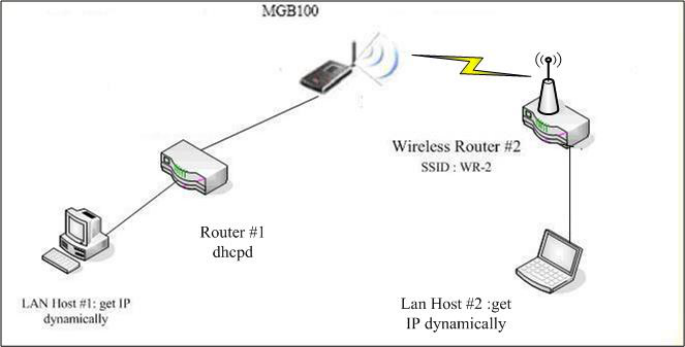
below Figure1 is for the reference. First, check which channel you want to
use. For example, channel 10. Scan other AP which channel is 10 and
supports WDS function. Second, add the wireless MAC address of
MGB100 in this Wireless Router # 2. (Figure2). And use Scan AP to find
the wireless which SSID is “WR-2” and join it in the list. Third, if it is normal,
LAN-Host#1 can find the devices, like Wireless Router #2 and
LAN-Host#2.
Figure 1:
66
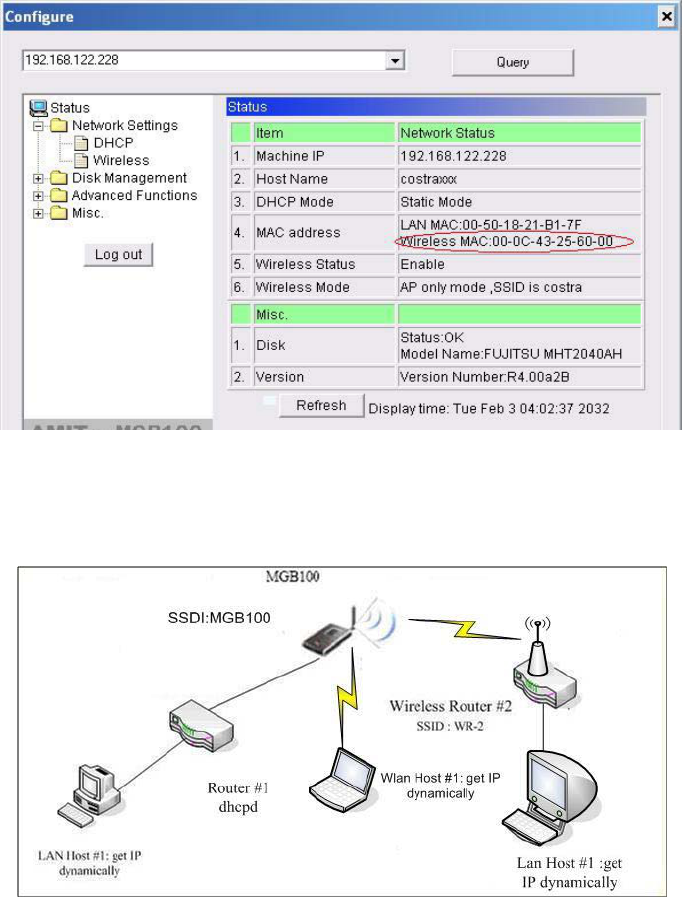
Figure2:
WDS Hybrid mode: This device also supports WDS and AP mode at the
same time. How to configure this in your circumstance? The below figure
is for the reference.
67
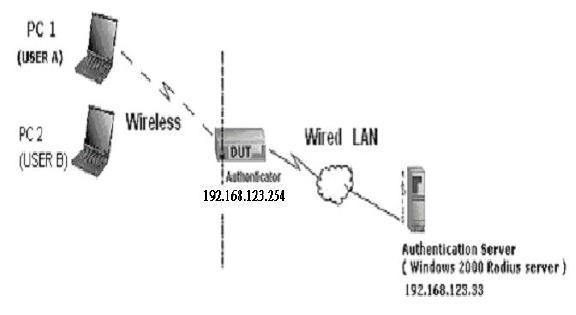
For the setting of WDS, please refer to the above WDS only mode.
For AP setting, please refer to the AP mode.
2. How to configure 802.1x or WPA with Radius server?
Equipment Details
PC1:
Microsoft Windows XP Professional without Service Pack 1.
D-Link DWL-650+ wireless LAN adapter
Driver version: 3.0.5.0 (Driver date: 03.05.2003)
PC2:
Microsoft Windows XP Professional with Service Pack 1a.
Z-Com XI-725 wireless LAN USB adapter
Driver version: 1.7.29.0 (Driver date: 10.20.2001)
Authentication Server: Windows 2000 RADIUS server with Service
68

69
Pack 3 and HotFix Q313664.
Note. Windows 2000 RADIUS server only supports PEAP after upgrade
to service pack 3 and HotFix Q313664 (You can get more information
from http://support.microsoft.com/default.aspx?scid=kb;
en-us;313664)
DUT Configuration:
1. Enable DHCP server.
2. WAN setting: static IP address.
3. LAN IP address: 192.168.123.254/24.
4. Set RADIUS server IP.
5. Set RADIUS server shared key.
6. Configure WEP key and 802.1X setting.
The following test will use the inbuilt 802.1X authentication method such
as EAP_TLS, PEAP_CHAPv2 (Windows XP with SP1 only), and
PEAP_TLS (Windows XP with SP1 only) using the Smart Card or other
Certificate of the Windows XP Professional.
DUT and Windows 2000 RADIUS Server Setup
1. Setup Windows 2000 RADIUS Server. We have to change
authentication method to MD5_Challenge or using smart card or other
certificate on RADIUS server according to the test condition.
2. Setup DUT
9 Enable the 802.1X (check the “Enable checkbox“).
70
9 Enter the RADIUS server IP.
9 Enter the shared key. (The key shared by the RADIUS server
and DUT).
9 We will change 802.1X encryption key length to fit the
variable test condition.
3. Setup Network adapter on PC
9 Choose the IEEE 802.1X as the authentication method.
(Figure 2)
Note. Figure 2 is a setting picture of Windows XP without service
pack 1. If users upgrade to service pack 1, then they can’t see
MD5-Challenge from EAP type list any more, but they will get a
new Protected EAP (PEAP) option.
9 Choose MD5-Challenge or Smart Card or other Certificate as
the EAP type.
9 If choosing use smart card or the certificate as the EAP type,
we select to use certificate on this computer.
9 We will change EAP type to fit the variable test condition.
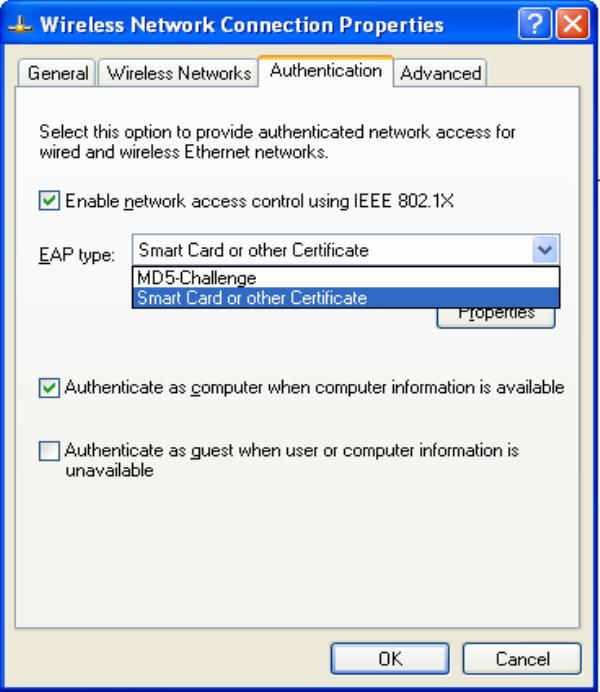
Figure 2: Enable IEEE 802.1X access control
71
72
Windows 2000 RADIUS server Authentication testing:
1. DUT authenticate PC1 using certificate. (PC2 follows the same test
procedures.)
2. Download and install the certificate on PC1. (Figure 4)
3. PC1 choose the SSID of DUT as the Access Point.
4. Set authentication type of wireless client and RADIUS server both
to EAP_TLS.
5. Disable the wireless connection and enable again.
6. The DUT will send the user's certificate to the RADIUS server, and
then send the message of authentication result to PC1. (Figure 5)
7. Windows XP will prompt that the authentication process is success
or fail and end the authentication procedure. (Figure 6)
8. Terminate the test steps when PC1 get dynamic IP and PING
remote host successfully.
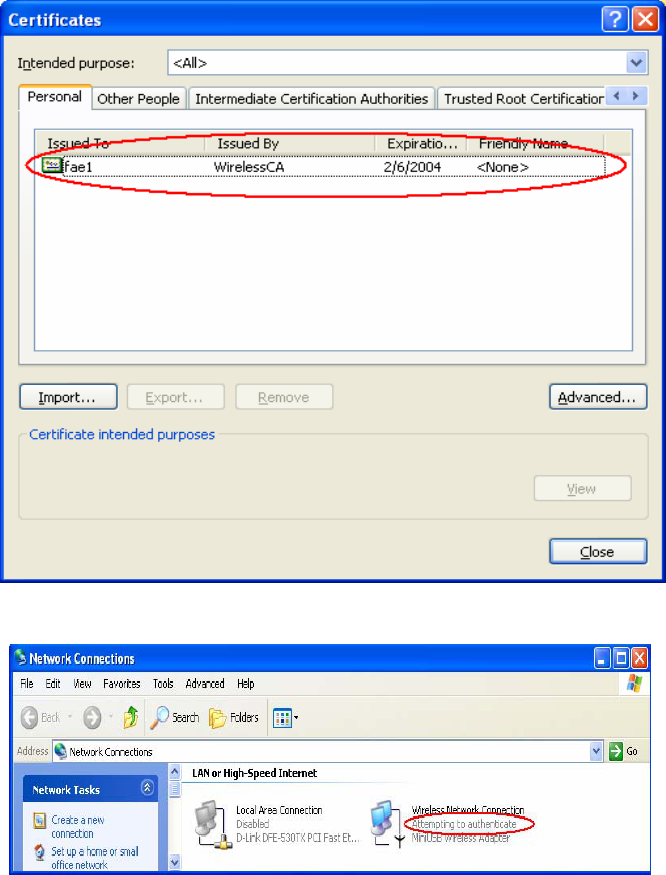
Figure 4: Certificate information on PC1
Figure 5: Authenticating
73
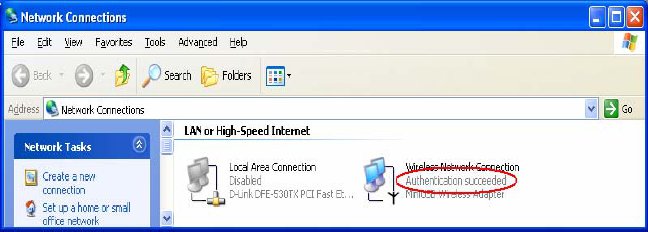
Figure 6: Authentication success
DUT authenticate PC2 using PEAP-TLS.
1. PC2 choose the SSID of DUT as the Access Point.
2. Set authentication type of wireless client and RADIUS server both
to PEAP_TLS.
3. Disable the wireless connection and enable again.
4. The DUT will send the user's certificate to the RADIUS server, and
then send the message of authentication result to PC2.
5. Windows XP will prompt that the authentication process is success
or fail and end the authentication procedure.
6. Terminate the test steps when PC2 get dynamic IP and PING
remote host successfully.
74
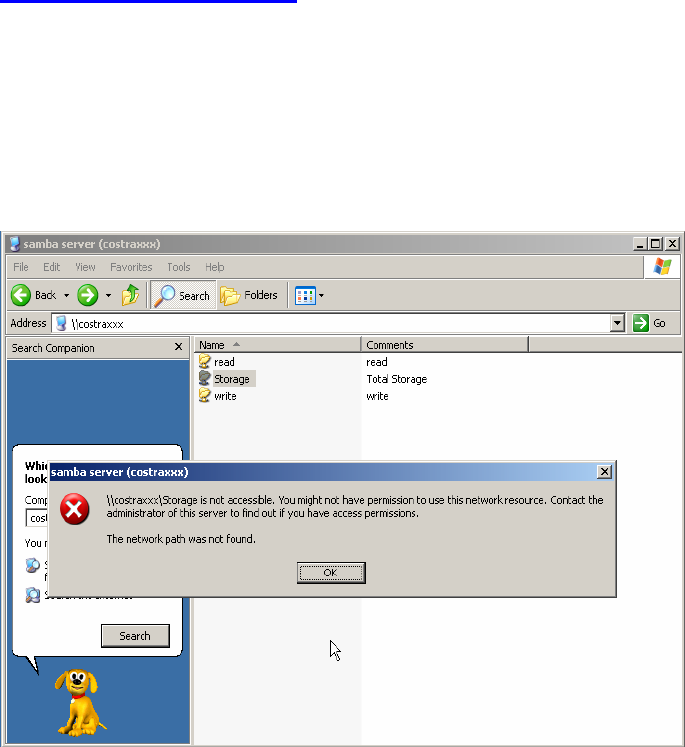
Problems of security level
1. Why can’t I access the file from my places after enabling Security
Level?
A: Sometimes, I can not access the folders via my places after enabling
Security Level, like below:
If the user sees the warning message, please restart windows and try it
again. But there are some situations that the users can not access this
folder if even they input correct the account and password as below:
75
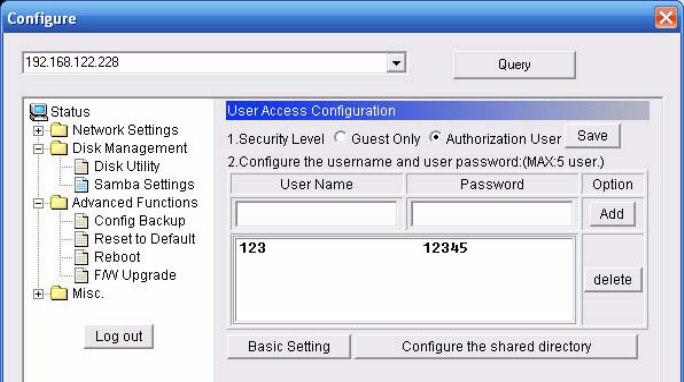
Situation 1: The users can access the files or folders before MGB100 is
not enabled “security Level”. But when MGB100 is enabled it, the
authorization users can not login by inputting the account and password.
Please restart your window OS and It can be accessed.
Situation 2: Change the account and password of MGB100. In brief, the
users have some Limit authority to access the folders, but if someone
changes account and password this time, other authorization users can
not access at all. Please restart your window OS.
This is because the windows will cache some records so that the settings
can not work immediately and the users have no idea to restart the device.
2. How do I configure the authority of file-shared by my places and ftp
service?
A: Take an example as follows:
First, Set account 123 and password 12345.
Then Click Configure the shared directory.
76
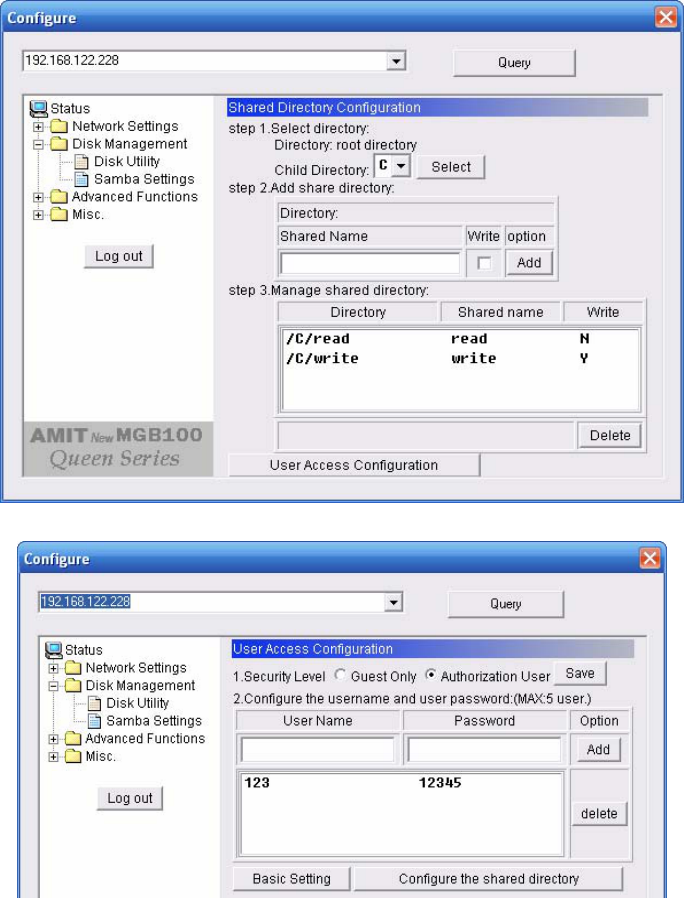
Create two folders. One is “read”, and the other is “write”. The authority is
as follows:
Then click the User Access Configuration and save “Security Level”.
77
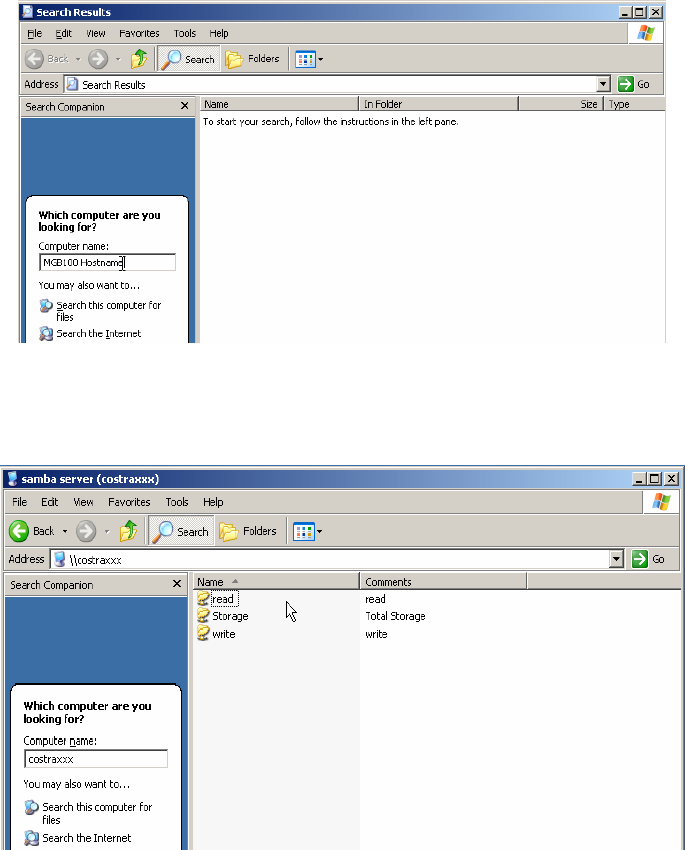
Use search MGB100 hostname, if you can not access the directory
“Storage”.
Then you will find the MGB100 and will find some folders, like read, write
and Storage.
78
79
If you are a guest and you just can copy the files in the folder ”read” and
copy, move and delete the files or folders in the folder ”write”.
※But if you are an Authorization user. Anyway you directly click the
folders “read and write”. However, you just have the same limits of
authority with guests. Please login the folder “Storage” to begin.
This product also defines two user-level(Guest and Authorization users) to
share files by ftp service.
The configuration is the same with above. There are two folders to share.
If the users use guest to login ftp service, he just accesses read or write
folders. Or login as Authorization users, he can access all.
FCC RF Radiation Exposure Statement
1. The antenna(s) used for this transmitter must be installed to provide a separation
distance of at least 20 cm from all persons and must not be co-located or operating
in conjunction with any other antenna or transmitter.
2. Changes or modifications to this unit not expressly approved by the party
responsible for compliance could void the user authority to operate the equipment.